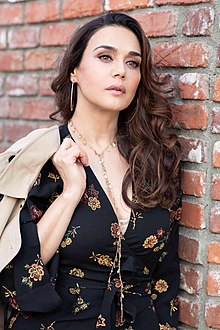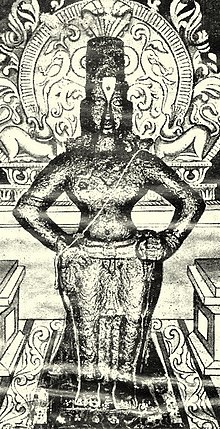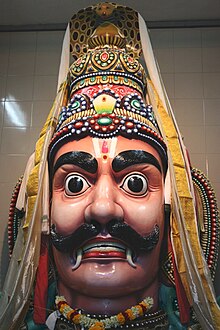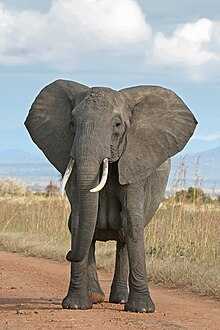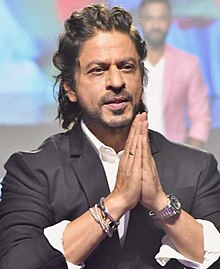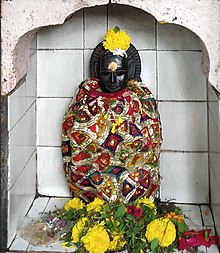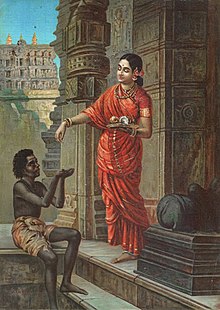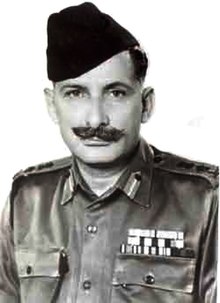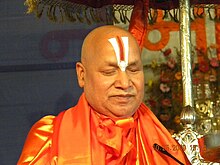Portal:India
Portal maintenance status: (June 2018)
|
Introduction


India, officially the Republic of India, is a country in South Asia. It is the seventh-largest country by area; the most populous country as of June 2023; and since its independence in 1947, the world's most populous democracy. Bounded by the Indian Ocean on the south, the Arabian Sea on the southwest, and the Bay of Bengal on the southeast, it shares land borders with Pakistan to the west; China, Nepal, and Bhutan to the north; and Bangladesh and Myanmar to the east. In the Indian Ocean, India is near Sri Lanka and the Maldives; its Andaman and Nicobar Islands share a maritime border with Thailand, Myanmar, and Indonesia. (Full article...)
 Featured article – show another
Featured article – show another
-
Image 1
The Western Chalukya Empire (/tʃəˈluːkjə/ chə-LOO-kyə) ruled most of the western Deccan, South India, between the 10th and 12th centuries. This Kannada-speaking dynasty is sometimes called the Kalyani Chalukya after its regal capital at Kalyani, today's Basavakalyan in the modern Bidar district of Karnataka state, and alternatively the Later Chalukya from its theoretical relationship to the 6th-century Chalukya dynasty of Badami. The dynasty is called Western Chalukyas to differentiate from the contemporaneous Eastern Chalukyas of Vengi, a separate dynasty. Before the rise of these Chalukyas, the Rashtrakuta Empire of Manyakheta controlled most of the Deccan Plateau and Central India for over two centuries. In 973, seeing confusion in the Rashtrakuta empire after a successful invasion of their capital by the ruler of the Paramara dynasty of Malwa, Tailapa II, a feudatory of the Rashtrakuta dynasty ruling from Bijapur region defeated his overlords and made Manyakheta his capital. The dynasty quickly rose to power and grew into an empire under Someshvara I who moved the capital to Kalyani.
For over a century, the two empires of South India, the Western Chalukyas and the Chola dynasty of Thanjavur fought many fierce wars to control the fertile region of Vengi. During these conflicts, the Eastern Chalukyas of Vengi, distant cousins of the Western Chalukyas but related to the Cholas by marriage, took sides with the Cholas further complicating the situation. During the rule of Vikramaditya VI, in the late 11th and early 12th centuries, the Western Chalukyas convincingly contended with the Cholas and reached a peak, ruling territories that spread over most of the Deccan, between the Narmada River in the north and Kaveri River in the south. His exploits were not limited to the south for even as a prince, during the rule of Someshvara I, he had led successful military campaigns as far east as modern Bihar and Bengal. During this period the other major ruling families of the Deccan, the Hoysala Empire, the Seuna dynasty, the Kakatiya dynasty and the Kalachuris of Kalyani, were subordinates of the Western Chalukyas and gained their independence only when the power of the Chalukya waned during the later half of the 12th century. (Full article...) -
Image 2Lage Raho Munna Bhai (pronounced [ləˈɡeː rəˈɦoː mʊnːaːˈbʱaːi] ⓘ; translation: Keep Going, Munna Bro) is a 2006 Indian Hindi-language satirical comedy drama film written, edited and directed by Rajkumar Hirani, who also co-wrote the screenplay with Abhijat Joshi, and produced by Vidhu Vinod Chopra under the banner Vinod Chopra Films. A sequel to Munna Bhai M.B.B.S. (2003), the film is the second installment of the Munna Bhai series. Sanjay Dutt and Arshad Warsi reprised their roles as the titular Munna Bhai and Circuit, respectively. New additions to the cast include Vidya Balan, Dilip Prabhavalkar and Dia Mirza, while several actors from the original, notably Jimmy Sheirgill and Boman Irani, appear in new roles.
In this film, the eponymous lead character, a don in the Mumbai underworld, begins to see visions of Mahatma Gandhi. Through his interactions with Gandhi, he begins to practice what he refers to as "Gandhigiri" (a neologism for "Gandhism") to help ordinary people solve their problems. (Full article...) -
Image 3
Shefali Shah (née Shetty; born 22 May 1973) is an Indian actress of film, television and theatre. Working primarily in independent Hindi films, she has received multiple local and foreign accolades for her performances. Shah's acting career started on the Gujarati stage before she debuted on television in 1993. After small parts on television and a brief stint with cinema in Rangeela (1995), she gained wider recognition in 1997 for her role in the popular series Hasratein. This was followed by lead roles in the TV series Kabhie Kabhie (1997) and Raahein (1999). A supporting role in the crime film Satya (1998) won her positive notice and a Filmfare Critics Award, and she soon shifted her focus to film acting starting with a lead role in the Gujarati drama Dariya Chhoru (1999).
Shah was selective about her roles through the following decades, resulting in intermittent film work, mostly in character parts and often to appreciation from critics. She appeared in the international co-production Monsoon Wedding (2001) and the mainstream comedy-drama Waqt: The Race Against Time (2005). In 2007, her portrayal of Kasturba Gandhi in the biographical drama Gandhi, My Father won her the Best Actress prize at the Tokyo International Film Festival, and she received the National Film Award for Best Supporting Actress for the drama film The Last Lear. Among her subsequent film roles, she played a leading part in Kucch Luv Jaisaa (2011) and was noted for her work in the social problem film Lakshmi (2014) and the ensemble drama Dil Dhadakne Do (2015). (Full article...) -
Image 4Nil Battey Sannata (lit. 'Zero Divided by Zero Equals Nothing'; slang for "Good for Nothing"), released internationally as The New Classmate, is a 2015 Indian Hindi-language comedy drama film directed by Ashwiny Iyer Tiwari in her feature debut. Produced by Aanand L. Rai, Ajay Rai, and Alan McAlex under the banners of Colour Yellow Productions and JAR Pictures, the film was co-written by Iyer, Neeraj Singh, Pranjal Choudhary, and Nitesh Tiwari. Swara Bhaskar starred as Chanda Sahay, a high-school drop-out household maid and single mother of a sullen young girl named Apeksha, played by Riya Shukla. The film's theme is a person's right to dream and change their lives, irrespective of social status.
Released in India on 22 April 2016, Nil Battey Sannata was distributed by Eros International and garnered critical and audience acclaim. Reviewers praised most aspects of the production, especially its narrative and realism, and the performances of the cast, Bhaskar's in particular. At the 62nd Filmfare Awards, Iyer won the Filmfare Award for Best Debut Director, while Bhaskar and Shukla won the Screen Awards for Best Actress (Critics) and Best Child Artist respectively. The film did well at the box-office, collecting a total of around ₹69 million (US$800,000) during its entire theatrical run. The same year, the film was remade in Tamil as Amma Kanakku, with Iyer returning to direct. The following year, it was remade in Malayalam as Udaharanam Sujatha. (Full article...) -
Image 5Waiting is a 2015 Indian Hindi-language drama film directed by Anu Menon. Produced by Priti Gupta and Manish Mundra under the banner of Ishka Films and Drishyam Films respectively, the film was co-written by Menon and James Ruzicka, and stars Naseeruddin Shah and Kalki Koechlin. Waiting focuses on the relationship between two people from different walks of life who befriend each other in a hospital, while nursing their respective comatose spouses. Rajat Kapoor, Suhasini Maniratnam, Arjun Mathur, Ratnabali Bhattacharjee and Rajeev Ravindranathan play supporting roles in the film.
The development of the film began in June 2014, when Menon signed Koechlin and Shah for an untitled project. Principal photography started in November 2014 in the South Indian coastal city of Kochi; Neha Parti served as the cinematographer for the film. New Zealand-based singer-songwriter Mikey McCleary composed the film's score. Nitin Baid and Apurva Asrani edited the film, and Atika Chohan wrote the dialogue. Waiting also marked the Hindi film debut of the prominent South Indian actress-director Suhasini Maniratnam. Koechlin also made her debut as a lyricist with the film's soundtrack, writing the song "Waiting for You". (Full article...) -
Image 6

Darjeeling (/dɑːrˈdʒiːlɪŋ/, Nepali: [ˈdard͡ziliŋ], Bengali: [ˈdarˌdʒiliŋ]) is a city in the northernmost region of the Indian state of West Bengal. Located in the Eastern Himalayas, it has an average elevation of 2,045 metres (6,709 ft). To the west of Darjeeling lies the easternmost province of Nepal, to the east the Kingdom of Bhutan, to the north the Indian state of Sikkim, and farther north the Tibet Autonomous Region region of China. Bangladesh lies to the south and southeast, and most of the state of West Bengal lies to the south and southwest, connected to the Darjeeling region by a narrow tract. Kangchenjunga, the world's third-highest mountain, rises to the north and is prominently visible on clear days.
In the early 19th century, during East India Company rule in India, Darjeeling was identified as a potential summer retreat for British officials, soldiers and their families. The narrow mountain ridge was leased from the Kingdom of Sikkim, and eventually annexed to British India. Experimentation with growing tea on the slopes below Darjeeling was highly successful. Thousands of labourers were recruited chiefly from Nepal to clear the forests, build European-style cottages and work in the tea plantations. The widespread deforestation displaced the indigenous peoples. Residential schools were established in and around Darjeeling for the education of children of the domiciled British in India. By the late-19th century, a novel narrow-gauge mountain railway, the Darjeeling Himalayan Railway, was bringing summer residents into the town and carrying a freight of tea out for export to the world. After India's independence in 1947, as the British left Darjeeling, its cottages were purchased by wealthy Indians from the plains and its tea plantations by out-of-town Indian business owners and conglomerates. (Full article...) -
Image 7Portrait by Rudolf Swoboda, 1888
Mohammed Abdul Karim (1863 — 20 April 1909), also known as "the Munshi", was an Indian attendant of Queen Victoria. He served her during the final fourteen years of her reign, gaining her maternal affection over that time.
Karim was born the son of a hospital assistant at Lalitpur, near Jhansi in British India. In 1887, the year of Victoria's Golden Jubilee, Karim was one of two Indians selected to become servants to the Queen. Victoria came to like him a great deal and gave him the title of "Munshi" ("clerk" or "teacher"). Victoria appointed him to be her Indian Secretary, showered him with honours, and obtained a land grant for him in India. (Full article...) -
Image 8

India, officially the Republic of India, is a country in South Asia. It is the seventh-largest country by area; the most populous country as of June 2023; and since its independence in 1947, the world's most populous democracy. Bounded by the Indian Ocean on the south, the Arabian Sea on the southwest, and the Bay of Bengal on the southeast, it shares land borders with Pakistan to the west; China, Nepal, and Bhutan to the north; and Bangladesh and Myanmar to the east. In the Indian Ocean, India is near Sri Lanka and the Maldives; its Andaman and Nicobar Islands share a maritime border with Thailand, Myanmar, and Indonesia.
Modern humans arrived on the Indian subcontinent from Africa no later than 55,000 years ago. Their long occupation, predominantly in isolation as hunter-gatherers, has made the region highly diverse, second only to Africa in human genetic diversity. Settled life emerged on the subcontinent in the western margins of the Indus river basin 9,000 years ago, evolving gradually into the Indus Valley Civilisation of the third millennium BCE. By 1200 BCE, an archaic form of Sanskrit, an Indo-European language, had diffused into India from the northwest. Its hymns recorded the dawning of Hinduism in India. India's pre-existing Dravidian languages were supplanted in the northern regions. By 400 BCE, caste had emerged within Hinduism, and Buddhism and Jainism had arisen, proclaiming social orders unlinked to heredity. Early political consolidations gave rise to the loose-knit Maurya and Gupta Empires. Widespread creativity suffused this era, but the status of women declined, and untouchability became an organized belief. In South India, the Middle kingdoms exported Dravidian language scripts and religious cultures to the kingdoms of Southeast Asia. (Full article...) -
Image 9
Kangna Amardeep Ranaut (pronounced [kəŋɡənaː raːɳoːʈʰ]; born 23 March 1986) is an Indian actress, filmmaker, and politician serving as a Member of Parliament, Lok Sabha from Mandi since June 2024. Known for her portrayals of strong-willed, unconventional women in female-led Hindi films, she is the recipient of several awards, including four National Film Awards and four Filmfare Awards, and has featured six times in Forbes India's Celebrity 100 list. In 2020, the Government of India honoured her with the Padma Shri, the country's fourth-highest civilian award.
At the age of sixteen, Ranaut briefly took up modelling before being trained under theatre director Arvind Gaur. She made her film debut in the 2006 thriller Gangster, for which she was awarded the Filmfare Award for Best Female Debut, and received praise for portraying emotionally intense characters in the dramas Woh Lamhe... (2006), Life in a... Metro (2007) and Fashion (2008). For the last of these, she won the National Film Award for Best Supporting Actress. She appeared in the commercially successful films Raaz: The Mystery Continues (2009) and Once Upon a Time in Mumbaai (2010) but was criticised for being typecast in neurotic roles. A comic role in Tanu Weds Manu (2011) was well-received, though this was followed by a series of brief, glamorous roles in films that failed to propel her career forward. (Full article...) -
Image 10
Preity G Zinta (pronounced [ˈpriːt̪i ˈzɪɳʈa]; born 31 January 1975) is an Indian actress and entrepreneur primarily known for her work in Hindi films. After graduating with degrees in English honours and criminal psychology, Zinta made her acting debut in Dil Se.. in 1998, followed by a role in Soldier in the same year. These performances earned her the Filmfare Award for Best Female Debut, and she was later recognised for her role as a teenage single mother in Kya Kehna (2000). She established a career as a leading Hindi film actress of the decade with a variety of character types. Her roles, often deemed culturally defiant, along with her unconventional screen persona won her recognition and several accolades.
Following critically appreciated roles in Chori Chori Chupke Chupke (2001), Dil Chahta Hai (2001), Dil Hai Tumhaara (2002), and Armaan (2003), Zinta received the Filmfare Award for Best Actress for her performance in Kal Ho Naa Ho (2003). She starred in two consecutive annual top-grossing films in India, Koi... Mil Gaya (2003) and Veer-Zaara (2004), and was noted for her portrayal of independent, modern Indian women in Salaam Namaste (2005) and Kabhi Alvida Naa Kehna (2006), top-grossing productions in domestic and overseas markets. For her first international role in the Canadian drama Heaven on Earth (2008) she was awarded the Silver Hugo Award for Best Actress and nominated for the Genie Award for Best Actress. She followed this with a hiatus from acting work for several years, with intermittent appearances such as in her self-produced comeback film, Ishkq in Paris (2013), which failed to leave a mark. (Full article...) -
Image 11The central image at Vithoba Temple in Pandharpur
Vithoba (IAST: Viṭhobā), also known as Vitthala (IAST: Viṭṭhala), and Panduranga (IAST: Pāṇḍuraṅga), is a Hindu deity predominantly worshipped in the Indian states of Maharashtra and Karnataka. He is a form of the Hindu deity Vishnu in his avatar: Krishna. Vithoba is often depicted as a dark young boy, standing arms akimbo on a brick, sometimes accompanied by his consort Rakhumai.
Vithoba is the focus of an essentially monotheistic, non-ritualistic bhakti-driven Varkari faith in Maharashtra and the Haridasa sect established in Dvaita Vedanta in Karnataka. Vithoba Temple, Pandharpur is his main temple. Vithoba legends revolve around his devotee Pundalik who is credited for bringing the deity to Pandharpur, and around Vithoba's role as a saviour to the poet-saints of the Varkari faith. The Varkari poet-saints are known for their unique genre of devotional lyric, the abhang, dedicated to Vithoba and composed in Marathi. Other devotional literature dedicated to Vithoba includes the Kannada hymns of the Haridasa and the Marathi versions of the generic aarti songs associated with rituals of offering light to the deity. The most important festivals of Vithoba are held on Shayani Ekadashi in the month of Ashadha, and Prabodhini Ekadashi in the month of Kartika. (Full article...) -
Image 12
Ram Narayan (IPA: [raːm naːˈɾaːjəɳ]; 25 December 1927 – 9 November 2024), often referred to with the title Pandit, was an Indian musician who popularised the bowed instrument sarangi as a solo concert instrument in Hindustani classical music and became the first internationally successful sarangi player.
Narayan was born near Udaipur and learned to play the sarangi at an early age. He studied under sarangi players and singers and, as a teenager, worked as a music teacher and travelling musician. All India Radio, Lahore, hired Narayan as an accompanist for vocalists in 1944. Narayan relocated to Delhi following the partition of India in 1947, but, wishing to go beyond accompaniment and frustrated with his supporting role, moved to Mumbai in 1949 to work in Indian cinema. (Full article...) -
Image 13Padukone at the 2018 Cannes Film Festival
Deepika Padukone (pronounced [d̪iːpɪkaː pəɖʊkoːɳeː]; born 5 January 1986) is an Indian actress who works predominantly in Hindi films. She is India's highest-paid actress, as of 2023, and her accolades include three Filmfare Awards. Time named her one of the 100 most influential people in the world in 2018 and awarded her the Time100 Impact Award in 2022.
Padukone, the daughter of the badminton player Prakash Padukone, was born in Copenhagen and raised in Bangalore. As a teenager, she played badminton in national level championships but left her career in the sport to become a fashion model. She soon received offers for film roles and made her acting debut in 2006 as the title character of the Kannada film Aishwarya. Padukone then played a dual role opposite Shah Rukh Khan in her first Bollywood release, the romance Om Shanti Om (2007), which won her the Filmfare Award for Best Female Debut. Padukone received praise for her starring role in the romance Love Aaj Kal (2009), but this was followed by a brief setback. (Full article...) -
Image 14
Vidya Balan (pronounced [ʋɪd̪ːja baːlən]; born 1 January 1979) is an Indian actress. Known for pioneering a change in the portrayal of women in Hindi cinema with her roles in female-led films, she is the recipient of several awards, including a National Film Award and seven Filmfare Awards. She was awarded the Padma Shri by the Government of India in 2014.
Vidya aspired to a career in film from a young age and had her first acting role in the 1995 sitcom Hum Paanch. While pursuing a master's degree in sociology from the University of Mumbai, she made several unsuccessful attempts to start a career in film, and featured in television commercials and music videos. She made her film debut by starring in the Bengali film Bhalo Theko (2003) and received praise for her first Hindi film, the drama Parineeta (2005). This was followed by commercial successes in Lage Raho Munna Bhai (2006) and Bhool Bhulaiyaa (2007), but her subsequent roles failed to propel her career forward. (Full article...) -
Image 15
INS Vikrant (from Sanskrit vikrānta, "courageous") was a Majestic-class aircraft carrier of the Indian Navy. The ship was laid down as HMS Hercules for the British Royal Navy during World War II, but was put on hold when the war ended. India purchased the incomplete carrier in 1957, and construction was completed in 1961. Vikrant was commissioned as the first aircraft carrier of the Indian Navy and played a key role in enforcing the naval blockade of East Pakistan during the Indo-Pakistani War of 1971.
In its later years, the ship underwent major refits to embark modern aircraft, before being decommissioned in January 1997. She was preserved as a museum ship in Naval Docks, Mumbai until 2012. In January 2014, the ship was sold through an online auction and scrapped in November 2014 after final clearance from the Supreme Court. (Full article...) -
Image 16

Nyctibatrachus major, the Malabar night frog, large wrinkled frog, or Boulenger's narrow-eyed frog is a species of frog in the family Nyctibatrachidae, commonly known as the robust frogs. It was described in 1882 by the zoologist George Albert Boulenger, and is the type species of the genus Nyctibatrachus. It is a large frog for its genus, with an adult snout–vent length of 31.5–52.0 mm (1.24–2.05 in) for males and 43.7–54.2 mm (1.72–2.13 in) for females. It is mainly brownish to greyish in colour, with a dark greyish-brown upperside, a greyish-white underside, and light grey sides. It also has a variety of grey or brown markings. When preserved in ethanol, it is mostly greyish-brown to grey, with whitish sides. Sexes can be told apart by the presence of the femoral glands (bulbous glands near the inner thigh) in males.
The species is endemic to the Western Ghats mountain range of India, where it is found in Kerala, Tamil Nadu, and Karnataka. Adults inhabit fast-moving forest streams at elevations of up to 900 m (3,000 ft) and have highly specific habitat requirements. Adults are mostly found in or near water and are nocturnal; subadults can be found during both the night and day. Its diet mainly consists of other frogs and insect larvae. Over a period of several days or weeks, females lay multiple small clutches of eggs on leaves and rocks overhanging water; tadpoles drop into the water below on hatching. The species is currently classified as being vulnerable on the IUCN Red List owing to its small and fragmented range and ongoing habitat degradation. Threats to the species include habitat loss, increased human presence near the streams it inhabits, and possibly nitrate pollution caused by fertiliser overuse. (Full article...) -
Image 17A Bengal tigress in Kanha Tiger Reserve, India
The tiger (Panthera tigris) is a large cat and a member of the genus Panthera native to Asia. It has a powerful, muscular body with a large head and paws, a long tail and orange fur with black, mostly vertical stripes. It is traditionally classified into nine recent subspecies, though some recognise only two subspecies, mainland Asian tigers and the island tigers of the Sunda Islands.
Throughout the tiger's range, it inhabits mainly forests, from coniferous and temperate broadleaf and mixed forests in the Russian Far East and Northeast China to tropical and subtropical moist broadleaf forests on the Indian subcontinent and Southeast Asia. The tiger is an apex predator and preys mainly on ungulates, which it takes by ambush. It lives a mostly solitary life and occupies home ranges, defending these from individuals of the same sex. The range of a male tiger overlaps with that of multiple females with whom he mates. Females give birth to usually two or three cubs that stay with their mother for about two years. When becoming independent, they leave their mother's home range and establish their own. (Full article...) -
Image 18Bhatt at the 2022 Berlinale
Alia Bhatt (/ˈɑːliə ˈbʌt/; born 15 March 1993) is a British actress of Indian descent who predominantly works in Hindi films. Known for her portrayals of women in challenging circumstances, she has received several accolades, including a National Film Award and six Filmfare Awards. She is one of India's highest-paid actresses. Time awarded her with the Time100 Impact Award in 2022 and named her one of the 100 most influential people in the world in 2024.
Born into the Bhatt family, she is a daughter of filmmaker Mahesh Bhatt and actress Soni Razdan. After making her acting debut as a child in the 1999 thriller film Sangharsh, she played her first leading role in Karan Johar's teen film Student of the Year (2012). She won the Filmfare Critics Award for Best Actress for playing a kidnapping victim in the road drama Highway (2014) and went on to establish herself with starring roles in several romantic films produced by Johar's studio Dharma Productions. (Full article...) -
Image 19Portrait by Alexander Bassano, 1882
Victoria (Alexandrina Victoria; 24 May 1819 – 22 January 1901) was Queen of the United Kingdom of Great Britain and Ireland from 20 June 1837 until her death in 1901. Her reign of 63 years and 216 days—which was longer than those of any of her predecessors—constituted the Victorian era. It was a period of industrial, political, scientific, and military change within the United Kingdom, and was marked by a great expansion of the British Empire. In 1876, the British parliament voted to grant her the additional title of Empress of India.
Victoria was the daughter of Prince Edward, Duke of Kent and Strathearn (the fourth son of King George III), and Princess Victoria of Saxe-Coburg-Saalfeld. After the deaths of her father and grandfather in 1820, she was raised under close supervision by her mother and her comptroller, John Conroy. She inherited the throne aged 18 after her father's three elder brothers died without surviving legitimate issue. Victoria, a constitutional monarch, attempted privately to influence government policy and ministerial appointments; publicly, she became a national icon who was identified with strict standards of personal morality. (Full article...) -
Image 20
Brigadier-General Robert Montagu Poore, CIE, DSO, DL, JP (20 March 1866 – 14 July 1938) was an Anglo-Irish cricketer and British Army officer who, while serving in South Africa in 1896, played in three Test matches for the South African cricket team. He featured most prominently in first-class cricket playing county cricket in England for Hampshire between 1898 and 1906, where he gained a reputation as a batsman, having notable success in 1899 when he was the highest first-class run-scorer in England. Alongside playing for Hampshire, Poore also played first-class cricket in India for the Europeans in the Bombay Presidency Matches. An all-round sportsman, he was also a capable swordsman, and polo, tennis, racquets, and squash player, in addition to being a skilled marksman. Poore had success in the Royal Naval and Military Tournaments, being adjudged the best man-at-arms on four occasions.
Poore began his military service in the Volunteer Force with the 3rd (Royal Wiltshire Militia) Battalion of the Wiltshire Regiment in 1883, before gaining a regular commission in the British Army in 1886. From there, he transferred to the 7th Hussars in the same year and shortly after served in British India, where he was aide-de-camp to the Governor of Bombay. Poore served in the Second Matabele War in Southern Africa and later in the Second Boer War from 1899 to 1902, during which he was seconded to the Mounted Military Police and served as provost marshal at Army Headquarters Pretoria. In this role, he played an important part in investigating and recording the war–crimes trial and execution of Breaker Morant and Peter Handcock. Decorated with the Distinguished Service Order during the war, Poore later returned to the Hussars and served in the First World War between 1914 and 1918, commanding the Jhansi Brigade of the British Indian Army from 1915, for which he was made a Companion of the Order of the Indian Empire in 1918. He retired from active military service in 1921. In later life, he was a deputy lieutenant for Dorset. (Full article...) -
Image 21
Kalidas (pronounced [kaːɭidaːs] transl. The Servant of Kali) is a 1931 Indian biographical film directed by H. M. Reddy and produced by Ardeshir Irani. It is notable for being the first sound film in the Tamil and Telugu languages, and the first sound film to be made in a Dravidian language. It was based on the life of the Sanskrit poet Kalidasa, hence its namesake; it featured P. G. Venkatesan in the title role and T. P. Rajalakshmi as the female lead, with L. V. Prasad, Thevaram Rajambal, T. Susheela Devi, J. Sushila, and M. S. Santhanalakshmi in supporting roles.
Kalidas, principally in Tamil, contained additional dialogue in Telugu and Hindi. While Rajalakshmi spoke Tamil, Venkatesan spoke only Telugu due to his lack of fluency in Tamil, and Prasad spoke only Hindi. Despite its mythological theme, the film featured songs from much later time periods, such as the compositions of Carnatic musician Tyagaraja, publicity songs of the Indian National Congress, and songs about Mahatma Gandhi and the Indian independence movement. The sound was recorded using German-made technology. Kalidas was shot in Bombay on the sets of India's first sound film Alam Ara (1931) and was completed in eight days. (Full article...) -
Image 22
Sonam Kapoor Ahuja (pronounced [soːnəm kəˈpuːr]; born 9 June 1985) is an Indian actress who works in Hindi films. She has received several awards, including a National Film Award and a Filmfare Award. One of the highest-paid Hindi film actresses in the 2010s, Kapoor appeared in Forbes India's Celebrity 100 list from 2012 to 2016.
Kapoor, the daughter of actor Anil Kapoor, began her career as an assistant director on filmmaker Sanjay Leela Bhansali's 2005 film Black. She made her acting debut in Bhansali's romantic drama Saawariya (2007), a box office flop, and had her first commercial success with the romantic comedy I Hate Luv Storys (2010). This was followed by a series of commercial failures and repetitive roles, which garnered her negative reviews. The 2013 box office hit Raanjhanaa marked a turning point in Kapoor's career, garnering her praise and Best Actress nominations at several award ceremonies. (Full article...) -
Image 23Gemini (/dʒɛminɪ/) is a 2002 Indian Tamil-language crime action film written and directed by Saran with Pon Elango as assistant director. This film was produced by AVM Productions. The film stars Vikram in the main lead role, while Kiran Rathod, Murali, Kalabhavan Mani, Vinu Chakravarthy, Manorama and Thennavan portray significant roles. Based on gang wars in Chennai, the film delves into the lives of outlaws and the roles the police and society play in their rehabilitation and acceptance.
In early 2001, rival gangsters "Vellai" Ravi and Chera reformed themselves with the patronage of a police officer. Saran was inspired by this incident and scripted a story based on it. Production began shortly afterwards in December the same year and was completed by March 2002. The film was shot mainly at the AVM Studios in Chennai, while two song sequences were filmed in Switzerland. The film had cinematography by A. Venkatesh and editing by Suresh Urs while the soundtrack was scored by Bharadwaj. (Full article...) -
Image 24Aravan worshipped at Sri Mariamman Temple, Singapore. A cobra hood is sheltering Aravan's head.
Iravan also known as Iravat and Iravant, is a minor character from the Hindu epic Mahabharata. The son of Pandava prince Arjuna (one of the main heroes of the Mahabharata) and the Naga princess Ulupi, Iravan is the central deity of the cult of Kuttantavar (Kuttandavar) which is also the name commonly given to him in that tradition—and plays a major role in the sect of Draupadi. Both these sects are of Tamil origin, from a region of the country where he is worshipped as a village deity and is known as Aravan. He is also a patron god of well-known transgender communities called Alis (also Aravani in Tamil, and Hijra throughout South Asia).
The Mahabharata portrays Iravan as dying a heroic death on the 8th day of the 18-day Kurukshetra War (Mahabharata war), the epic's main subject. However, the South Indian traditions have a supplementary practice of honouring Aravan's self-sacrifice to the goddess Kali to ensure her favour and the victory of the Pandavas in the war. The Kuttantavar tradition focuses on one of the three boons granted to Aravan by the god Krishna in honour of this self-sacrifice. Aravan requested that he be married before his death. Krishna satisfied this boon in his female form, Mohini. In Koovagam, Tamil Nadu, this incident is re-enacted in an 18-day festival, first by a ceremonial marriage of Aravan to Alis (hijra) and male villagers (who have taken vows to Aravan) and then by their widowhood after ritual re-enactment of Aravan's sacrifice. (Full article...) -
Image 25A female African bush elephant in Mikumi National Park, Tanzania
Elephants are the largest living land animals. Three living species are currently recognised: the African bush elephant (Loxodonta africana), the African forest elephant (L. cyclotis), and the Asian elephant (Elephas maximus). They are the only surviving members of the family Elephantidae and the order Proboscidea; extinct relatives include mammoths and mastodons. Distinctive features of elephants include a long proboscis called a trunk, tusks, large ear flaps, pillar-like legs, and tough but sensitive grey skin. The trunk is prehensile, bringing food and water to the mouth and grasping objects. Tusks, which are derived from the incisor teeth, serve both as weapons and as tools for moving objects and digging. The large ear flaps assist in maintaining a constant body temperature as well as in communication. African elephants have larger ears and concave backs, whereas Asian elephants have smaller ears and convex or level backs.
Elephants are scattered throughout sub-Saharan Africa, South Asia, and Southeast Asia and are found in different habitats, including savannahs, forests, deserts, and marshes. They are herbivorous, and they stay near water when it is accessible. They are considered to be keystone species, due to their impact on their environments. Elephants have a fission–fusion society, in which multiple family groups come together to socialise. Females (cows) tend to live in family groups, which can consist of one female with her calves or several related females with offspring. The leader of a female group, usually the oldest cow, is known as the matriarch. (Full article...)
Selected pictures
-
Image 1Photograph: Muhammad Mahdi KarimAn Indian palm squirrel (Funambulus palmarum) photographed in Bangalore, India. In India these squirrels are associated with the Hindu deity Rama, an avatar of Vishnu, and as such are not to be harmed. However, in Western Australia they are considered pests and at times targeted for eradication.
-
Image 2Photograph: Yann; edit: Jim CarterA view of the Taj Mahal from the south, featuring the Charbagh garden. The mausoleum complex also includes subsidiary tombs, waterworks infrastructure, the small town of Taj Ganji, and a "moonlight garden". Its origins and architecture have been extensively documented, covering both the circumstances of its commission and the cultural and historical influence of the Islamic Mughal Empire in India.
-
Image 3Photo: Muhammad Mahdi KarimThe glass house at Lal Bagh, a botanical garden in Bangalore, India. The garden was commissioned by the ruler of Mysore, Hyder Ali in 1760, and completed during the reign of his son Tipu Sultan. The glass house was modeled on London's Crystal Palace and constructed at the end of the 19th century.
-
Image 4Photo: YannWomen of the Gondi, the largest tribe of Indian aboriginals in central India. They are classified as a Scheduled Tribe in most Indian states. The Gondi language is related to Telugu and other Dravidian languages. About half of Gonds speak Gondi languages, while the rest speak Indo-Aryan languages including Hindi. For many years during the British colonial period, the Gonds were considered to have performed human sacrifices, although this notion was later discredited.
-
Image 5Photograph credit: Charles J. SharpThe Indian roller (Coracias benghalensis) is a member of the bird family Coraciidae, the rollers. It occurs widely from the Arabian Peninsula to the Indian subcontinent and is designated as Least Concern on the IUCN Red List. The bird is best known for the aerobatic displays of males during the breeding season. It is commonly found in open grassland and scrub forest habitats, and is often seen perched on roadside bare trees and wires, which give it a good view of the ground below where it finds its prey. Its diet consists mainly of insects such as beetles and grasshoppers, but also includes spiders, scorpions, amphibians and small reptiles. The largest population occurs in India, and several states in India have chosen it as their state bird.
This picture shows an Indian roller of the benghalensis subspecies, photographed in Kanha Tiger Reserve in the Indian state of Madhya Pradesh. -
Image 6Photograph: Jorge RoyanAn Indian merchant holding green chickpeas (Cicer arietinum). One of the earliest cultivated legumes, chickpeas are ingredients in a number of dishes around the world. India is the largest producer of this nutrient-dense food, accounting for 64% of global production in 2016.
-
Image 7A potter at work in Jaura, Madhya Pradesh, India. Pottery, defined by ASTM International as "all fired ceramic wares that contain clay when formed, except technical, structural, and refractory products", originated during the Neolithic period.
-
Image 8Al-Ameen College of PharmacyPhoto: Muhammad Mahdi KarimAl-Ameen College of Pharmacy is a pharmacy college in Bangalore, India. Established in 1983, it is under the purview of the Al-Ameen Educational Society.
-
Image 9Photograph credit: Prathyush ThomasMacrotyloma uniflorum, commonly known as horse gram, is a legume native to tropical southern Asia. The plant grows from a rhizome, sending up annual shoots to a height of 60 cm (24 in). The flowers are cream, yellow or pale green and are followed by short pods. The seeds, pictured here, have been consumed in India for at least 4,000 years and are used both for animal feed and human consumption, including Ayurvedic cuisine. In other tropical countries in southeastern Asia, and in northern Australia, the plant is grown mainly as a fodder crop and for use as green manure. It is a drought-tolerant plant, largely cultivated in areas with low rainfall.
-
Image 10Papilio demoleus matingPhotograph: JkadavoorA mating pair of Papilio demoleus, a common and widespread Swallowtail butterfly, photographed at Kadavoor, Kerala, India. After successful mating the female goes from plant to plant, laying a single egg at a time on top of a leaf, and flies off as soon as the egg is laid.
-
Image 11Photograph: Augustus BinuChandiroor Divakaran (b. 1946) is a Malayalam–language poet and folk song writer from Kerala, India. He has published numerous collections of poetry since his debut collection, Radha, in 1965.
-
Image 12Photograph credit: Augustus BinuPomegranate juice is a beverage made from the fruit of the pomegranate. It is used in cooking both as a fresh juice and as a concentrated syrup. The fruit originated in the region extending from Iran to northern India and has been cultivated since ancient times. The fruit has a hard outer husk and a spongy mesocarp in which the seeds in their fleshy seedcoats are embedded. Pomegranate juice can be sweet or sour, but most fruits are moderate in taste. The juice has long been a popular drink in Europe and the Middle East, and is now widely distributed in the United States and Canada.
-
Image 13Bangalore Town Hall is a neoclassical municipal building in Bangalore, India. It is sometimes known, after a former president of Bangalore, as the Sir K. P. Puttanna Chetty Town Hall. Built by Mirza Ismail in 1935, it underwent renovations in 1990 at a cost of ₹6.5 million (US$371,400 at the time).
-
Image 14Photograph credit: Jeevan JosePapilio polymnestor, the blue Mormon, is a species of swallowtail butterfly found in southern India and Sri Lanka. It is a woodland species, often seen on forest paths and near streams. The larvae feed on trees in the family Rutaceae, such as citrus. Young larvae are green with white markings and position themselves on the upper surface of leaves, relying on their cryptic colouring, which resembles bird droppings, for protection. Older larvae seek less conspicuous locations, and have a unique habit of securing their balance by weaving silk on the substratum. This adult male P. polymnestor butterfly was photographed in the Indian state of Kerala.
-
Image 15
 Coin design credit: East India Company and the Calcutta Mint; photographed by Andrew ShivaThe mohur is a gold coin that was formerly minted by several governments, including those of British India. It was usually equivalent in value to fifteen silver rupees. Gold mohurs issued by the British East India Company or the Crown are valuable collectors' items, and sell in auctions for high prices. The double mohur (minted between 1835 and 1918), with a value of thirty rupees, is the highest-denomination circulating coin ever issued in India. The 1835 two-mohur coin above was minted in the reign of King William IV, while the 1862 one-mohur coin below was minted in the reign of Queen Victoria; both are now part of the National Numismatic Collection at the National Museum of American History.
Coin design credit: East India Company and the Calcutta Mint; photographed by Andrew ShivaThe mohur is a gold coin that was formerly minted by several governments, including those of British India. It was usually equivalent in value to fifteen silver rupees. Gold mohurs issued by the British East India Company or the Crown are valuable collectors' items, and sell in auctions for high prices. The double mohur (minted between 1835 and 1918), with a value of thirty rupees, is the highest-denomination circulating coin ever issued in India. The 1835 two-mohur coin above was minted in the reign of King William IV, while the 1862 one-mohur coin below was minted in the reign of Queen Victoria; both are now part of the National Numismatic Collection at the National Museum of American History.
 Featured list – show another
Featured list – show another
-
Image 1
-
Image 2Enthiran (transl. Robot) is a 2010 Indian Tamil-language science fiction film directed by S. Shankar and produced by Kalanithi Maran. Shankar wrote the screenplay and co-wrote the dialogues with Sujatha and Madhan Karky. The film stars Rajinikanth and Aishwarya Rai with Danny Denzongpa, Santhanam, and Karunas playing supporting roles. The musical score was composed by A. R. Rahman while the cinematography, visual effects, editing, and art direction were handled by R. Rathnavelu, V. Srinivas Mohan, Anthony, and Sabu Cyril respectively. The film's story revolves around a scientist's struggle to control his creation, an android robot whose software is upgraded to give it the ability to comprehend and generate human emotions. The plan backfires when the robot falls in love with the scientist's fiancée and is further manipulated by a rival scientist to bring destruction to all who stand in its way. The film was dubbed into Hindi as Robot.
Produced on an estimated budget of ₹1.32 billion, Enthiran was released on 1 October 2010 and yielded a revenue of ₹1.79 billion according to a report by the Sun TV Network. The film garnered awards and nominations in several categories, with particular praise for its cinematography, visual effects, art direction, costume design, and Rajinikanth's performance. The film has won 25 awards from 38 nominations. (Full article...) -
Image 3

Asin in 2012
Asin is a former Indian actress who is known for her work in Tamil, Telugu and Hindi language films. She made her acting debut at the age of 15 in the Malayalam-language satirical comedy-drama Narendran Makan Jayakanthan Vaka in 2001. Asin had her first commercial success with the Telugu film Amma Nanna O Tamila Ammayi (2003). For her performance as a Tamil girl in the film, she received the Filmfare Best Telugu Actress Award. In the same year she won the Santosham Best Actress Award for her role in Telugu film Sivamani. In her next two Telugu releases: Lakshmi Narasimha (2004) and Gharshana (2004), Asin played the love interest of a police officer. Lakshmi Narasimha was a commercial success, while Gharshana received mixed reviews from critics but later gained a cult following.
She made her debut in Tamil cinema in the 2004 sports drama M. Kumaran Son of Mahalakshmi, a commercial success. The 2005 action thriller Ghajini marked a turning point in her career. Her role as a vivacious young model named Kalpana won her the Filmfare Best Tamil Actress Award. This led to a series of lead roles in commercially successful films, including the action film Sivakasi (2005), the thriller Varalaru (2006), the action thriller Pokkiri (2007), the action drama Vel (2008) and the science fiction film Dasavathaaram (2008), which established her as a leading actress of Tamil cinema. (Full article...) -
Image 4

Virat Kohli is the leading century maker, with eight centuries to his name.
In cricket, a batter reaches a century when he scores 100 runs or more in a single innings. A century is regarded as a landmark score for a batter, and his number of centuries is generally recorded in his career statistics. The Indian Premier League (IPL) is a professional league for Twenty20 cricket in India, which has been held annually since its first edition in 2008. Till date, 101 centuries have been scored by 53 different batsmen, out of which 27 are Indian players and 26 are overseas players. Players from 12 of the 15 franchises have scored centuries, with the three franchises that have not had a player score a century for them being Pune Warriors India, Kochi Tuskers Kerala and Gujarat Lions. (Full article...) -
Image 5
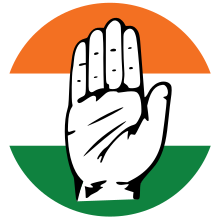
The national president of the Indian National Congress is the chief executive of the Indian National Congress (INC), one of the principal political parties in India. Constitutionally, the president is elected by an electoral college composed of members drawn from the Pradesh Congress Committees and members of the All India Congress Committee (AICC). In the event of any emergency because of any cause such as the death or resignation of the president elected as above, the most senior general secretary discharges the routine functions of the president until the Working Committee appoints a provisional president pending the election of a regular president by the AICC. The president of the party has effectively been the party's national leader, head of the party's organisation, head of the Working Committee, the chief spokesman, and all chief Congress committees.
After the party's foundation in December 1885, Womesh Chandra Banerjee became its first president. From 1885 to 1933, the presidency had a term of one year only. From 1933 onwards, there was no such fixed term for the president. During Jawaharlal Nehru's premiership, he rarely held the Presidency of INC, even though he was always head of the Parliamentary Party. Despite being a party with a structure, Congress under Indira Gandhi did not hold any organisational elections after 1978. In 1978, Gandhi split from the INC and formed a new opposition party, popularly called Congress (I), which the national election commission declared to be the real Indian National Congress for the 1980 general election. Gandhi institutionalised the practice of having the same person as the Congress president and the prime minister of India after the formation of Congress (I). Her successors Rajiv Gandhi and P. V. Narasimha Rao also continued that practice. Nonetheless, in 2004, when the Congress was voted back into power, Manmohan Singh became the first and only prime minister not to be the president of the party since establishment of the practice of the president holding both positions. (Full article...) -
Image 6
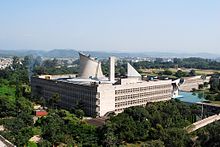
The Punjab Legislative Assembly is the unicameral state legislature of Punjab state in North India. The seat of the Legislative Assembly is at Chandigarh, the capital of the state. It is housed within the Chandigarh Capitol Complex, a World Heritage Site designed by Le Corbusier. The term of the assembly is five years, unless it is dissolved earlier. Since 1977, it has had 117 members who are directly elected, from single-seat constituencies.
Since the independence of India, the Scheduled Castes (SC) and Scheduled Tribes (ST) have been given Reservation status, guaranteeing political representation, and the Constitution lays down the general principles of positive discrimination for SCs and STs. The 2011 census of India stated that there were no people of any Scheduled Tribes in Punjab, while the Scheduled Castes constituted a significant portion of the population of the state, at 31.9%. The Scheduled Castes have been granted a reservation of 34 seats in the assembly. (Full article...) -
Image 7

The Mizoram Legislative Assembly is the unicameral legislature of Mizoram state in Northeast India. The seat of the legislative assembly is at Aizawl, the capital of the state. The assembly comprises 40 members directly elected from single-seat constituencies. It sits for a term of five years, unless it is dissolved earlier. Early dissolution of state assemblies happens when the governing party (or alliance) loses confidence of the assembly. This leads to either the President's Rule being imposed on the state, or early elections being called. Mizoram is the fourth-smallest state in India, covering 21,081 km2 (8,139 sq mi); and the second-least populous state with a population of 1.10 million. The Mizoram Legislative Assembly has existed since 1972, when it had 30 constituencies.
Since the independence of India, the Scheduled Castes (SC) and Scheduled Tribes (ST) have been given Reservation status, guaranteeing political representation, and the Constitution lays down the general principles of positive discrimination for STs and SCs. The 2011 census of India stated that the indigenous population constitutes 95% of the state's total population. The Scheduled Tribes have been granted a reservation of 39 seats in the Mizoram assembly, leaving only one (Aizawl East-I) unreserved. (Full article...) -
Image 8Khan at an event for Jawan in 2023
Shah Rukh Khan is an Indian actor, producer and television personality who works in Hindi films. He began his acting career by playing a soldier in the Doordarshan series Fauji (1988), a role that garnered him recognition and led to starring roles in more television shows. He soon started receiving film offers and had his first release with the romantic drama Deewana (1992), in which he played a supporting part. Khan subsequently played villainous roles in the 1993 thrillers Baazigar and Darr, box office successes that established his career in Bollywood. In 1995, Khan starred opposite Kajol in Aditya Chopra's romance Dilwale Dulhania Le Jayenge, that became the longest running Indian film of all time. He continued to establish a reputation in romantic roles by playing opposite Madhuri Dixit in Dil To Pagal Hai (1997), and Kajol in the Karan Johar-directed Kuch Kuch Hota Hai (1998) and Kabhi Khushi Kabhie Gham... (2001).
In 1999, Khan collaborated with Aziz Mirza and Juhi Chawla to start a production company, Dreamz Unlimited, whose first release was the comedy-drama Phir Bhi Dil Hai Hindustani (2000) starring Khan and Chawla. The film was a commercial failure as was their next production, Aśoka (2001), leading to a setback. His career prospects improved in 2002 when he starred alongside Dixit and Aishwarya Rai in Devdas, a period romance that garnered him critical acclaim. In 2004, he collaborated with his wife Gauri Khan to launch another company, Red Chillies Entertainment, whose first feature was the box office hit Main Hoon Na (2004). Khan's popularity continued to increase in the 2000s as he played the romantic lead opposite younger actresses, most notably Rani Mukerji and Preity Zinta, in several top-grossing productions, including Kal Ho Naa Ho (2003), Veer-Zaara (2004) and Kabhi Alvida Naa Kehna (2006). He also played against type as a NASA scientist in the drama Swades (2004), a hockey coach in the sports film Chak De! India (2007), and an autistic man in the drama My Name Is Khan (2010). (Full article...) -
Image 9Dookudu (transl. Aggression) is a 2011 Indian Telugu-language action comedy film directed by Srinu Vaitla, and jointly produced by Ram Achanta, Gopi Achanta and Anil Sunkara. The film features Mahesh Babu, Samantha, Prakash Raj, and Sonu Sood in the lead roles, and Brahmanandam, and M. S. Narayana in supporting roles. It was edited by M. R. Varma and the cinematography was provided by K. V. Guhan and Prasad Murella. The film's musical and background score were composed by S. Thaman.
Partially inspired by the 2003 German tragicomedy film Good Bye, Lenin!, Dookudu revolves around the life of police officer Ajay Kumar (Mahesh). His father Shankar Narayana (Prakash Raj) awakes from a coma, which he has been in for many years after an accident, but his health remains perilous. To aid his recovery, Kumar masquerades as a Member of the Legislative Assembly fulfilling his father's ambition for him. (Full article...) -
Image 10

Kapoor in 2022
Ranbir Kapoor is an Indian actor who appears in Hindi films. He worked as an assistant director on the films Aa Ab Laut Chalen (1999) and Black (2005), before making his acting debut opposite Sonam Kapoor in Sanjay Leela Bhansali's romantic drama Saawariya (2007). It earned Kapoor the Filmfare Award for Best Male Debut. He established himself in 2009 with leading roles in three films—the coming-of-age drama Wake Up Sid, the comedy Ajab Prem Ki Ghazab Kahani and the drama Rocket Singh: Salesman of the Year. He won the Filmfare Critics Award for Best Actor for his combined work in these three films. In 2010, Kapoor played a character based on Arjuna and Michael Corleone in the commercially successful political thriller Raajneeti.
From 2011 to 2013, Kapoor's releases were among the highest-grossing Hindi films of their respective years. In Imtiaz Ali's musical Rockstar (2011), he played an aspiring singer, and in Anurag Basu's comedy-drama Barfi! (2012), he starred as a joyful deaf and mute man. His performance in both films was critically acclaimed and he earned two consecutive Best Actor awards at Filmfare and the former also earned him a Filmfare Critics Award for Best Actor. The romantic comedy Yeh Jawaani Hai Deewani (2013) further established him as a star. (Full article...) -
Image 11

The chief minister of Chhattisgarh is the chief executive of the Indian state of Chhattisgarh. In accordance with the Constitution of India, the governor is a state's de jure head, but de facto executive authority rests with the chief minister. Following elections to the legislative assembly, the state's governor usually invites the party (or coalition) with a majority of seats to form the government. The governor appoints the chief minister, whose council of ministers are collectively responsible to the assembly. Given the confidence of the assembly, the chief minister's term is for five years and is subject to no term limits.
Four people have served as the state's chief minister since Chhattisgarh's formation on 1 November 2000 as a result of the Madhya Pradesh Reorganisation Act, 2000. The first was Ajit Jogi of the Indian National Congress. He was succeeded in 2003 by Raman Singh of the Bharatiya Janata Party (BJP) who served three consecutive five-year terms. The third person to serve in the office was Congress leader Bhupesh Baghel ,who served from 2018 to 2023. He was succeeded by Vishnu Deo Sai of the BJP, the current incumbent. (Full article...) -
Image 12

Khan in 2017
Indian actor Aamir Khan first appeared on screen at the age of eight in a minor role in his uncle Nasir Hussain's film Yaadon Ki Baaraat (1973). In 1983, he acted in and worked as an assistant director on Paranoia, a short film directed by Aditya Bhattacharya, following which he assisted Hussain on two of his directorial ventures—Manzil Manzil (1984) and Zabardast (1985). As an adult, Khan's first acting project was a brief role in the 1984 experimental social drama Holi.
Khan's first leading role came opposite Juhi Chawla in the highly successful tragic romance Qayamat Se Qayamat Tak (1988). His performance in the film and in the thriller Raakh (1989) earned him a National Film Award – Special Mention. He went on to establish himself with roles in several lucrative films of the 1990s, including the romantic drama Dil (1990), the comedy-drama Hum Hain Rahi Pyar Ke (1993), and the romance Raja Hindustani (1996). He also played against type in the Deepa Mehta-directed Canadian-Indian co-production Earth (1998). In 1999, Khan launched a production company, Aamir Khan Productions, whose first release Lagaan (2001) was nominated for the Academy Award for Best Foreign Language Film, and earned him the National Film Award for Best Popular Film. Also in 2001, he starred alongside Saif Ali Khan and Akshaye Khanna in the acclaimed coming-of-age drama Dil Chahta Hai. Lagaan and Dil Chahta Hai are cited in the media as defining films of Hindi cinema. After a three-year hiatus, Khan portrayed the eponymous lead in Mangal Pandey: The Rising (2005), a period film that underperformed at the box office, after which he played leading roles in two top-grossing films of 2006—Fanaa and Rang De Basanti. (Full article...) -
Image 13

Bowlers have taken fifty-three five-wicket hauls in Tests and two five-wicket hauls in One Day International matches played at Chepauk.
M. A. Chidambaram Stadium (MAC), also known as the Chepauk Stadium or simply Chepauk due its location in the city's locality of Chepauk, is a sports ground in Chennai, India that has hosted international cricket matches along with provincial games. Named after M. A. Chidambaram, former President of Board of Control for Cricket in India (BCCI), the venue was formerly known as the Madras Cricket Club ground. It has a capacity of 38,000 spectators for international matches. It is the home ground of the Tamil Nadu cricket team and the Indian Premier League team Chennai Super Kings. The first Test at this venue took place in 1934, between India and England. As of February 2021, it has hosted a further 33 Test matches. Chepauk has also staged 22 One Day International (ODI) matches, the first of which was in 1987 when Australia defeated India in a group-match during the 1987 World Cup.
In cricket, a five-wicket haul (also known as a "five-for" or "fifer") refers to a bowler taking five or more wickets in a single innings. This is regarded as a notable achievement. The first bowler to take a five-wicket haul in a Test match at Chepauk was Amar Singh for India against England in 1934; he finished the innings with bowling figures of 7 wickets for 86 runs. Australia's Ashley Mallett became the first to take two five-wicket hauls in the same match at Chepauk, when he took 5 for 91 and 5 for 53 in the second and fourth innings of the fifth Test of Australia's 1969–70 tour of India. Narendra Hirwani is the most recent cricketer and the first Indian to take two five-wicket hauls on debut. He took 8 for 61 and 8 for 75 against the West Indies during the fourth Test of the 1987–88 series between the teams, which was held at this ground, and finished the match with bowling figures of 16 for 136. These are also the best match-figures by any bowler on Test debut. The best figures in Test cricket at Chepauk are 8 for 55, taken by India's Vinoo Mankad against England in 1952. Axar Patel took the most recent five-wicket haul at Chepauk, with figures of 5 for 60 against England in their 2020–21 tour of India. As of September 2024, 33 bowlers have taken 53 Test match five-wicket hauls at this ground. (Full article...) -
Image 14
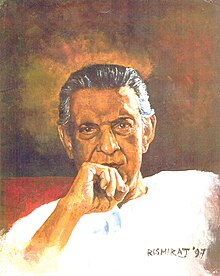
A portrait of Satyajit Ray
Satyajit Ray (listen; 2 May 1921 – 23 April 1992) was an Indian filmmaker who worked prominently in Bengali cinema and who has often been regarded as one of the greatest and most influential directors in the History of cinema. Ray was born in Calcutta (now Kolkata) to a Bengali family and started his career as a junior visualiser. His meeting with French film director Jean Renoir, who had come to Calcutta in 1949 to shoot his film The River (1951), and his 1950 visit to London, where he saw Vittorio De Sica's Ladri di biciclette (Bicycle Thieves) (1948), inspired Ray to become a film-maker. Ray made his directorial debut in 1955 with Pather Panchali and directed 36 films, comprising 29 feature films, five documentaries, and two short films.
Although Ray's work generally received critical acclaim, his film Pather Panchali and Ashani Sanket (1973) were criticised for "exporting poverty" and "distorting India's image abroad". His Apu Trilogy (1955–1959) appeared in Time's All-Time 100 Movies in 2005. Aside from directing, Ray composed music and wrote screenplays for films, both his own and those by other directors. Often credited as a fiction writer, illustrator, and calligrapher; Ray authored several short stories and novels in Bengali, most of which were aimed at children and adolescents. Some of his short stories have been adapted into films by other directors, including his only son, Sandip Ray. Considered a cultural icon in India and acknowledged for his contribution to Indian cinema, Ray has influenced several filmmakers around the world, including Wes Anderson, Martin Scorsese, James Ivory, François Truffaut, Carlos Saura, and Christopher Nolan. (Full article...) -
Image 15

Basu at the audio release of Creature 3D
Bipasha Basu is an Indian actress who has featured in over 50 films, predominantly in Hindi language. After a successful career as a model, she made her film debut with a supporting role in Abbas–Mustan's thriller Ajnabee (2001), which won her the Filmfare Award for Best Female Debut. Basu followed this with a role in her first Telugu cinema—the action film Takkari Donga (2002). She had her first major success with the supernatural thriller Raaz (2002), which earned Basu her first Filmfare Award for Best Actress nomination. The following year, she starred opposite John Abraham in the erotic thriller Jism, in which she played a seductive wife. She received a Filmfare Award for Best Performance in a Negative Role nomination for the film. Her roles in these films established her as a sex symbol.
Basu followed this initial success with roles in a series of commercial failures, including the thrillers Aetbaar, Rudraksh, Rakht—all in 2004—and the romance Barsaat (2005). She later featured in Prakash Jha's crime drama Apaharan (2005) and the ensemble comedy No Entry (2005). The latter emerged as a financial success, grossing ₹750 million (US$8.7 million) at the box office, and Basu's role of an escort earned her a nomination for the Best Supporting Actress at the 51st Filmfare Awards. Basu had seven film releases in 2006. Her role as an executive at a conglomerate in Madhur Bhandarkar's drama Corporate earned her another nomination for the Filmfare Award for Best Actress. She then portrayed a character based on Bianca in Vishal Bhardwaj's Omkara, an adaptation of the Shakespearean tragedy Othello. In Sanjay Gadhvi's action film Dhoom 2—her final release of the year—she played dual roles; it was the top-grossing Bollywood film of the year. In 2008, she collaborated with Abbas–Mustan for the second time for Race. Her performance as a troubled wife in Rituparno Ghosh's 2009 Bengali film Shob Charitro Kalponik was critically acclaimed. She then featured in the third installment of the Raaz series, entitled Raaz 3D (2012). Due to her frequent associations with horror films, she was labelled India's "horror queen" by the media. (Full article...) -
Image 16

Yash Chopra, the founder of Yash Raj Films, pictured in 2012. He directed 13 films for the company between 1973 and 2012.
Yash Raj Films (abbreviated as YRF) is an Indian entertainment company, established by filmmaker Yash Chopra in 1970, that produces and distributes motion pictures. As of 2022, the company has produced over 80 Hindi films and one Tamil film. YRF started a film distribution business in 1997; in addition to distributing their own productions, the company has handled the domestic and/or international distribution of over 50 films from other companies. The most frequent collaborations of the company have been with the actors Rani Mukerji, Rishi Kapoor, Shah Rukh Khan, Anushka Sharma, Katrina Kaif, and Saif Ali Khan.
YRF's first release came in 1973 with the Chopra-directed Daag, a drama about bigamy, starring Rajesh Khanna, Raakhee and Sharmila Tagore. The company had four more releases in the 1970s, including the ensemble romantic drama Kabhi Kabhie and the action film Kaala Patthar, both of which starred Amitabh Bachchan and Raakhee. YRF's sole commercial success in the 1980s was the Sridevi-starring romantic musical Chandni. The year 1995 marked the directorial debut of Chopra's elder son Aditya Chopra with the highly successful romantic drama Dilwale Dulhania Le Jayenge. Starring Shahrukh Khan and Kajol, the film has the longest theatrical run in Indian cinema history. Other successful releases of the 1990s were Darr (1993) and Dil To Pagal Hai (1997), both starring Khan. (Full article...) -
Image 17
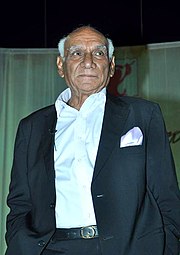
Chopra in 2012
Yash Chopra (1932–2012) was an Indian film director and producer known for his works in Bollywood. Acknowledged as one of the greatest filmmakers from the country, he was credited by the media for "changing the face of romance to become a brand" in the industry. He made his directorial debut with the family drama Dhool Ka Phool, which was produced by his elder brother Baldev Raj. The film, released in 1959, became a commercial success worldwide and gave him critical acclaim. Chopra's next film, Dharmputra (1961), failed to perform well at the box office but won the National Film Award for Best Feature Film in Hindi. In 1965, he directed the drama Waqt about a family who are separated due to a natural disaster. A commercial success, it was one of the earliest Indian films to star an ensemble cast and won a first Best Director trophy for him at the Filmfare Awards.
The 1980s was the most unsuccessful period of his career. Following the failure of his romantic drama Silsila (1981), which he co-wrote, directed and produced, Chopra's popularity began to wane. According to his biographer, the British academic Rachel Dwyer, this was because action and crime films were more popular at the time while most of his films were romances. Chopra experimented with making two action films, Mashaal (1984) and Vijay (1988), which underperformed financially but were well received by critics. Chandni was his only box-office success of the decade. Starring Sridevi in the title role, the film tells the story of a young woman who is accused of being responsible for her lover's accident. Chopra's career began to revive since its premiere in 1989; the film was named the Best Popular Film Providing Wholesome Entertainment at the 37th National Film Awards and considered one of his best films. (Full article...) -
Image 18

Shetty at the trailer launch of Baahubali: The Beginning (2015)
Anushka Shetty is an Indian actress who appears in Telugu and Tamil films.She is often considered one of the greatest, most influential actress in the history of Telugu Cinema . With a cinematic career spanning over two decades, she has played pivotal roles in over 50 films. She is often hailed as the "Lady Superstar" of South Indian Cinema. She made her acting debut in Puri Jagannadh's 2005 Telugu film Super, and appeared in Mahanandi, released later the same year. The following year, she had four releases, the first being S. S. Rajamouli's Vikramarkudu, which helped her gain recognition, followed by Astram (a remake of the 1999 Hindi film Sarfarosh), the Sundar C-directed Rendu, (which marked her debut in Tamil cinema), and a special appearance in AR Murugadoss' Telugu film Stalin. She had two releases in 2007: Lakshyam and Don. In 2008, she appeared in six films, including Okka Magaadu, Swagatam and Souryam. In 2009, Shetty played two roles in the fantasy Arundhati. She went on to win the Nandi Special Jury Award and the Filmfare Best Telugu Actress Award for this film. Her next release that year was Billa, a Telugu remake of the 2007 Tamil film of the same name. Her final release in 2009 was her second Tamil feature film, the masala film Vettaikaaran, where she appeared as a medical student.
Shetty had a string of releases in 2010. She portrayed a prostitute in Krish's Vedam, which won her the Filmfare Award for Best Telugu Actress. Despite critical acclaim, the film failed at the box office. None of her other releases in 2010 succeeded commercially, except for her sole Tamil release of the year, the masala Singam. The following year, Anushka had two releases, both in Tamil. She reprised her Vedam role in its remake Vaanam, then appeared as an advocate in the A. L. Vijay-directed Deiva Thirumagal, a loose adaptation of the American film I Am Sam (2001). The following year, she also had two releases: Thaandavam in Tamil, and Damarukam in Telugu. Her first release in 2013 was Suraj's Tamil masala Alex Pandian, a critical and commercial failure. This was followed by Mirchi in Telugu, Singam II (where she reprised her role from Singam), and Selvaraghavan's Tamil romantic fantasy Irandaam Ulagam where she played three distinct roles. Her sole release of 2014 was K. S. Ravikumar's Lingaa. (Full article...) -
Image 19The Chameli Devi Jain Award for Outstanding Woman Mediaperson is an Indian journalism award named after Chameli Devi Jain, an Indian independence activist who became the first Jain woman to go to prison during India's independence struggle. The award was instituted in 1980 by The Media Foundation and is given to women in the field of journalism. According to Business Standard, the award is "perhaps India's longest running media award for women".
The Media Foundation was founded in 1979 by B. G. Verghese, Lakshmi Chand Jain, Prabhash Joshi, Ajit Bhattacharjea and N. S. Jagannathan. The award was instituted in 1980 by Verghese and the family of Chameli Devi. The criteria for selection include social concern, dedication, courage and compassion in the individual's work. Journalists in print, digital and broadcast are eligible including photographers, cartoonists and newspaper designers; the entries are judged by an independent jury. Preferences are given to rural or small-town journalists and journalists in regional Indian languages. (Full article...) -
Image 20

Haider is a 2014 Indian crime-drama film directed by Vishal Bhardwaj, and produced by Bhardwaj and Siddharth Roy Kapur. The film stars Shahid Kapoor as the eponymous protagonist, and co-stars Tabu, Kay Kay Menon, Shraddha Kapoor, and Irrfan Khan. Bhardwaj wrote the dialogues for the film, and co-wrote the screenplay with Basharat Peer. Bhardwaj also composed the music and Gulzar wrote the lyrics. The film is a modern-day adaptation of William Shakespeare's tragedy Hamlet, and tells the story of Haider who searches for his missing father during the Kashmir conflict of 1995.
Produced on a budget of ₹240 million (US$2.8 million), Haider was released on 2 October 2014, and grossed ₹690 million (US$8.0 million) worldwide. The film garnered awards and nominations in several categories, with particular praise for its direction, performances of Shahid Kapoor and Tabu, music and production design. As of June 2015, the film has won 36 awards. (Full article...) -
Image 21
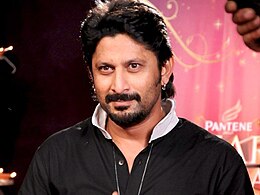
Warsi in 2010
Arshad Warsi started his career as an assistant director to Mahesh Bhatt in Kaash (1987). Warsi choreographed the title song of Roop Ki Rani Choron Ka Raja (1993), before making his acting debut in the Amitabh Bachchan-produced Tere Mere Sapne (1996). It was followed by Betaabi (1997), Hero Hindustani (1998), Hogi Pyaar Ki Jeet and Trishakti (both 1999), among others, but most of these films failed to do well at the box office. In 2003, he had his breakthrough by playing the comic sidekick Circuit in Rajkumar Hirani's comedy-drama Munna Bhai M.B.B.S. His performance garnered him the Zee Cine Award for Best Actor in a Comic Role and received nominations for the Filmfare, IIFA, Screen and Apsara Film Producers Guild Award for Best Supporting Actor. Warsi won the GIFA Best Comedian Award for his role in the comedy Hulchul (2004), and garnered critical acclaim for portraying a police officer in the crime drama Sehar (2005). He received his second Filmfare Award for Best Supporting Actor nomination for his role in the romantic comedy Salaam Namaste (2005).
In 2006, Warsi starred in the Rohit Shetty-directed comedy Golmaal: Fun Unlimited, and reprised his role of Circuit in the sequel Lage Raho Munna Bhai. His performance in the latter won him the Filmfare Award for Best Performance in a Comic Role, among other awards. That same year, he played lead roles in the mystery Anthony Kaun Hai? and the counter-terrorism drama Kabul Express. Warsi also hosted the first season of the reality television show Bigg Boss for which he earned the Indian Television Academy Award for Best Anchor – Game/Quiz Show. In 2007, he played a footballer in the sports film Dhan Dhana Dhan Goal. The following year, he reteamed with Shetty for Golmaal Returns (2008), and played an intermittent explosive disorder patient in the comedy Krazzy 4 (2008). He won the Screen Award for Best Supporting Actor and received several nominations for playing a con man in the black comedy Ishqiya (2010). Also in 2010, Warsi co-produced and starred in the supernatural comedy-drama Hum Tum Aur Ghost, which performed poorly at the box office. Golmaal 3, the year's second-highest grossing Hindi film also featured him in a primary role. His first negative role came in 2013 with the action thriller Zila Ghaziabad, a critical and commercial failure. Warsi's portrayal of a lawyer in the comedy-drama Jolly LLB (2013), directed by Subhash Kapoor, garnered him several awards, including the IIFA Award for Best Performance in a Comic Role. His portrayal of a thief in Dedh Ishqiya (2014) attracted critical praise. (Full article...) -
Image 22
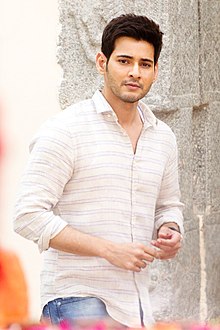
Mahesh Babu (born 9 August 1975) is an Indian actor, producer, and media personality who works in Telugu cinema. He is one of the highest-paid actors in Indian cinema. Born on the 9th of August, 1975, he first appeared in the 1979 film Needa when he was four years old. He continued to perform as a child actor in several films, most of which featured his father Krishna.Following his role as the titular protagonist in Balachandrudu (1990) while still a child, his career went on hiatus so he could concentrate on his education until taking on his first lead role as an adult in the 1999 film Rajakumarudu, for which he won the Nandi Award for Best Male Debut. Afterwards, his career stagnated until successes like Murari (2001), Okkadu (2003) and Athadu (2005) brought him fame..Athadu is widely considered to be a modern classic of Telugu cinema. It holds the record of being the most telecasted Telugu film with over 1,000 times on television.. In 2006, he played a gangster in the Puri Jagannadh-directed action-thriller Pokiri. The film became the highest-grossing Telugu film of all time, and according to Vogue India, cemented Babu's reputation as a "superstar". In its lifetime, Pokiri grossed ₹66 crore and collected a distributor share of ₹42 crore at the global box office.
In the wake of the failures of Sainikudu (2006) and Athidhi (2007), Babu took a long-term break from cinema for personal reasons. His next project, the fantasy action film Khaleja, was released in 2010 after significant delays.. The film was listed in the Film Companion's "25 Greatest Telugu Films of the Decade.". In 2011, he starred in Dookudu, which became the first Telugu film to gross over 100 crores. Businessman (2012), his next film, was well received and became one of the year's highest grossing Telugu films at a time that was particularly harsh on other big-budget productions. The film collected a distributor share of ₹44.8 crore and grossed over ₹90 crore in its lifetime at the global box office. The following year, Babu co-starred alongside Venkatesh in the critically and commercially acclaimed drama film Seethamma Vakitlo Sirimalle Chettu, which was considered the first Telugu multi-starrer in decades. Seethamma Vakitlo Sirimalle Chettu netted ₹38.75 crore at the AP/Nizam box office during its run, earning a distributor share of ₹51 crore at the global box office and declared a commercial success. He then featured in Sukumar's 2014 psychological thriller film 1: Nenokkadine. Although Babu's performance as a schizophrenic rock star was lauded by critics, the film itself received mixed reviews and failed to recover its budget. The film earned a distributor share of about ₹28.9 crore, on a budget of ₹70 crore..The film received mixed-to-positive reviews from critics, praising Sukumar's direction, screenplay, writing, musical score, emotional weight, cinematography, action sequences and cast performances (especially Babu), however the complexity in screenplay and length received mixed reception. The film won three awards from eight nominations at the 4th South Indian International Movie Awards, and two awards at the 11th CineMAA Awards. The film is considered one of the "25 Greatest Telugu Films Of The Decade" by Film Companion.. Aagadu, his next release that year, suffered a similar fate, despite the film's opening gross being his highest at the time. Aagadu grossed ₹18.02 crore within its first two days. However, it underperformed at the box office, failing to recover its budget of ₹65 crore during its theatrical run. The film's failure was primarily attributed to its similarities with Dookudu and other successful Telugu films. (Full article...) -
Image 23

The Padma Bhushan is the third-highest civilian award of the Republic of India. Instituted on 2 January 1954, the award is given for "distinguished service of a high order", without distinction of race, occupation, position, or sex. The recipients receive a Sanad, a certificate signed by the President of India and a circular-shaped medallion with no monetary association. The recipients are announced every year on Republic Day (26 January) and registered in The Gazette of India—a publication used for official government notices and released weekly by the Department of Publication, under the Ministry of Urban Development. The conferral of the award is not considered official without its publication in the Gazette. The name of recipient, whose award have been revoked or restored, both of which require the authority of the President, is archived and they are required to surrender their medal when their name is struck from the register; none of the conferments of Padma Bhushan during 1960–1969 have been revoked or restored. The recommendations are received from all the state and the union territory governments, as well as from Ministries of the Government of India, the Bharat Ratna and the Padma Vibhushan awardees, the Institutes of Excellence, the Ministers, the Chief Ministers and the Governors of State, and the Members of Parliament including private individuals.
When instituted in 1954, the Padma Bhushan was classified as "Dusra Varg" (Class II) under the three-tier Padma Vibhushan awards, which were preceded by the Bharat Ratna in hierarchy. On 15 January 1955, the Padma Vibhushan was reclassified into three different awards as the Padma Vibhushan, the Padma Bhushan and the Padma Shri. The criteria included "distinguished service of a high order in any field including service rendered by Government servants", but excluded those working with the public sector undertakings with the exception of doctors and scientists. The 1954 statutes did not allow posthumous awards; this was subsequently modified in the January 1955 statute. The design was also changed to the form that is currently in use; it portrays a circular-shaped toned bronze medallion 1+3⁄4 inches (44 mm) in diameter and 1⁄8 inch (3.2 mm) thick. The centrally placed pattern made of outer lines of a square of 1+3⁄16 inches (30 mm) side is embossed with a knob carved within each of the outer angles of the pattern. A raised circular space of diameter 1+1⁄16 inches (27 mm) is placed at the centre of the decoration. A centrally located lotus flower is embossed on the obverse side of the medal and the text "Padma" is placed above and the text "Bhushan" is placed below the lotus written in Devanagari script. The State Emblem of India is displayed in the centre of the reverse side, together with the national motto of India, "Satyameva Jayate" (Truth alone triumphs) in Devanagari script, which is inscribed on the lower edge. The rim, the edges and all embossing on either side is of standard gold with the text "Padma Bhushan" of gold gilt. The medal is suspended by a pink riband 1+1⁄4 inches (32 mm) in width with a broad white stripe in the middle. It is ranked fifth in the order of precedence of wearing of medals and decorations of the Indian civilian and military awards. (Full article...) -
Image 24
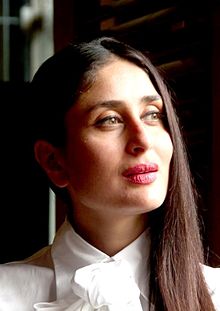
Kapoor Khan at an event for Bajrangi Bhaijaan in 2015
Kareena Kapoor Khan is an Indian actress who has appeared in more than 60 Hindi films. She made her acting debut opposite Abhishek Bachchan in the 2000 drama Refugee, for which she won the Filmfare Award for Best Female Debut. The following year, she appeared in five films, including the romance Mujhe Kucch Kehna Hai, the thriller Ajnabee, and the ensemble melodrama Kabhi Khushi Kabhie Gham.... The latter emerged as the highest-grossing Bollywood film in overseas to that point, and the success of these films established her in Bollywood. This success was followed by repetitive roles in a series of commercial failures.
In 2004, Kapoor portrayed a prostitute in the drama Chameli, which proved to be a turning point in her career, earning her a Filmfare Special Award. That same year, she played a Muslim woman affected by the 2002 Gujarat riots in Govind Nihalani's political drama Dev, and two years later, she played the Desdemona character in Omkara (2006), an adaptation of William Shakespeare's tragedy Othello from director Vishal Bhardwaj. She won two Filmfare Critics Award for Best Actress for these films. In 2007, Kapoor played a loquacious Sikh girl in Jab We Met, a commercially successful romantic comedy co-starring Shahid Kapoor, for which she won the Filmfare Award for Best Actress. (Full article...) -
Image 25The high courts of India are the highest courts of appellate jurisdiction in each state and union territory of India. However, a high court exercises its original civil and criminal jurisdiction only if the subordinate courts are not authorized by law to try such matters for lack of peculiar or territorial jurisdiction. High courts may also enjoy original jurisdiction in certain matters, if so designated, especially by the constitution, a state law or union law.
The work of most high courts primarily consists of appeals from lower courts and writ petitions in terms of Articles 226 and 227 of the Constitution. Writ jurisdiction is also the original jurisdiction of a high court. (Full article...)
 Good article – show another
Good article – show another
-
Image 1Dostana (transl. Friendship) is a 2008 Indian Hindi-language romantic comedy film written and directed by Tarun Mansukhani and produced by Hiroo Yash Johar and Karan Johar under Dharma Productions. The film stars Abhishek Bachchan, John Abraham, and Priyanka Chopra in lead roles. Set in Miami, it follows two men who pretend to be gay to share an apartment with a girl; eventually, both fall in love with her.
Mansukhani conceived the film as a tale of 3 friends living together, drawing inspiration from his own experience. Wanting to add something different to the script, he later decided to introduce homosexuality, which he thought was unexplored by Indian films, to shed light on the issue for the Indian audience. Manish Malhotra designed Chopra's costumes, and Aki Narula designed costumes for the rest of the cast. The soundtrack was composed by Vishal–Shekhar; Guptan, Kumaar and Vishal Dadlani wrote the lyrics, while Salim–Sulaiman composed the background score. Principal photography took place in Miami, Florida over a two-month period in the first half of 2008. Dostana was the first mainstream Indian film with a gay element and has been credited for exploring a topic largely ignored by Hindi cinema. (Full article...) -
Image 2

Blyth's kingfisher (Alcedo hercules) is the largest kingfisher in the genus Alcedo. Named for Edward Blyth, the species has also been known as Alcedo grandis and as the great blue kingfisher. Between 22 and 23 cm (8+5⁄8 and 9 in) long, the kingfisher has deep rufous underparts with a blackish blue breast patch, and brilliant cobalt blue or azure upperparts, tinged with purple. The wings are a dark blackish green, with blue speckles and tips to some of the feathers. The bill of the male is entirely black, while the female has a dark red lower mandible. The species is distinguished from the similar blue-eared kingfisher (Alcedo meninting) and common kingfisher (Alcedo atthis) by its greater size, heavy black bill, and dark lores.
The species breeds between the months of March and June. It builds nests at the end of tunnels dug in the banks of streams or ravines. Four to six eggs are laid, with both sexes incubating. A shy bird, it frequents small waterways, feeding on fish and insects caught by diving from a shrub close to the water. It is found along streams in evergreen forest and adjacent open country between 200 and 1,200 m (660 and 3,900 ft), mainly between 400 and 1,000 m (1,300 and 3,300 ft). The species ranges from Nepal through India, Bangladesh, Bhutan, China, Myanmar, Thailand, Laos, and Vietnam. Even within its preferred habitat the density of the species is low, and the population, though not thoroughly surveyed, is believed to be small, and declining further. The International Union for Conservation of Nature classifies it as "near threatened". (Full article...) -
Image 3Image of Kanhopatra in the Vithoba Temple, Pandharpur
Kanhopatra (or Kanhupatra) was a 15th-century Marathi saint-poet, venerated by the Varkari sect of Hinduism.
Little is known about Kanhopatra. According to most traditional accounts, Kanhopatra was a courtesan and dancer. These accounts typically concentrate on her death when she chose to surrender to the Hindu god Vithoba—the patron god of the Varkaris—rather than becoming a concubine of the Badshah (king) of Bidar. She died in the central shrine of Vithoba in Pandharpur. She is the only person whose samadhi (mausoleum) is within the precincts of the temple. (Full article...) -
Image 4
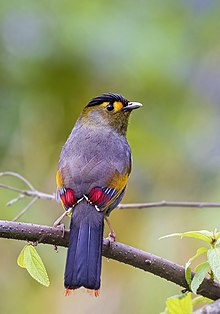
The Bugun liocichla (Liocichla bugunorum) is a passerine bird species from the family Leiothrichidae closely related to the Emei Shan liocichla. First spotted in 1995 in Arunachal Pradesh, India, it was described as a new species in 2006. The description was made without the collection of a type specimen as they were too few to risk killing one. It is thought to be an endangered species, with a small population, and a very restricted distribution range within which commercial development threatens the habitat. (Full article...) -
Image 5Raja Ravi Varma's lithograph on Mandodari
Mandodari (Sanskrit: मंदोदरी, Mandodarī, lit. "soft-bellied";) was the queen consort of Ravana, the king of Lanka, according to the Hindu epic Ramayana. The Ramayana describes her as beautiful, pious, and righteous. She is extolled as one of the Panchakanya, the recital of whose names is believed to dispel sin.
Mandodari was the daughter of Mayasura, the King of the Asuras (demons), and the apsara (celestial nymphs) Hema. She marries Ravana and bears three sons: Meghanada (Indrajit), Atikaya and Akshayakumara. According to some Ramayana adaptations, Mandodari is also the mother of Rama's wife Sita, who is infamously kidnapped by Ravana. Despite her husband's faults, Mandodari loves him and advises him to follow the path of righteousness. She repeatedly advises Ravana to return Sita to Rama, but her advice falls on deaf ears. Her love and loyalty to Rāvana are praised in the Rāmāyana. (Full article...) -
Image 6Witch hunts are still prevalent in India in the twenty-first century. Those who are labelled as witches are usually elderly or single women accused of manipulating supernatural forces with malicious intent. Witch branding occurs predominantly in rural, poorer areas of the country where there is often a higher concentration of tribal communities.
Multiple factors can lead to a witchcraft accusation, ranging from crop failure, financial hardship, and the loss of livestock to the illness or death of family members. Accusations are often instigated to serve ulterior motives like grabbing the land and property of a 'witch', settling personal grudges or even as a punishment for turning down sexual advances. There are also deeper underlying causes of witch hunting, primarily a lack of education and basic social benefits, particularly healthcare. (Full article...) -
Image 7Painting depicting Varaha by Raja Ravi Varma, circa 1930
Varaha (Sanskrit: वराह, Varāha, "boar") is the avatara of the Hindu god Vishnu, in the form of a boar. Varaha is generally listed as third in the Dashavatara, the ten principal avataras of Vishnu.
Varaha lifts the earth goddess Bhumi out of the cosmic ocean when the demon Hiranyaksha stole the earth goddess and hid her in the primordial waters, Vishnu appeared as Varaha to rescue her. Varaha killed Hiranyaksha and retrieved the earth goddess from the cosmic ocean, lifting it on his tusks, and restored her to her place in the universe. (Full article...) -
Image 8
Prince Siddhārtha leaving the palace on a horse during the Great Renunciation. Deities support the hooves of the horse. Approximately 2nd century, India
The Great Renunciation or Great Departure (Sanskrit: mahābhiniṣkramaṇa; Pali: mahābhinikkhamana)
is the traditional term for the departure of Gautama Buddha (c. 563–c. 483 BCE) from his palace at Kapilavastu to live a life as an ascetic (Sanskrit: śrāmaṇa, Pali: sāmaṇa). It is called the Great Renunciation because it is regarded as a great sacrifice. Most accounts of this event can be found in post-canonical Buddhist texts from several Buddhist traditions, which are the most complete. These are, however, of a more mythological nature than the early texts. They exist in Pāli, Sanskrit and Chinese language.
According to these accounts, at the birth of Prince Siddhārtha Gautama, the Buddha-to-be, brahmin priests predicted that he would either become a world teacher or a world ruler. To prevent his son from turning to religious life, Prince Siddhārtha's father and rāja of the Śākya clan Śuddhodana did not allow him to see death or suffering, and distracted him with luxury. During his childhood, Prince Siddhārtha had a meditative experience, which made him realize the suffering (Sanskrit: duḥkha, Pali: dukkha) inherent in all existence. He grew up and experienced a comfortable youth. But he continued to ponder about religious questions, and when he was 29 years old, he saw for the first time in his life what became known in Buddhism as the four sights: an old man, a sick person and a corpse, as well as an ascetic that inspired him. Shortly after, Prince Siddhārtha woke up at night and saw his female servants lying in unattractive poses, which shocked the prince. Moved by all the things he had experienced, the prince decided to leave the palace behind in the middle of the night against the will of his father, to live the life of an wandering ascetic, leaving behind his just-born son Rāhula and wife Yaśodharā. He traveled to the river Anomiya with his charioteer Chandaka and horse Kaṇṭhaka, and cut off his hair. Leaving his servant and horse behind, he journeyed into the woods and changed into monk's robes. Later, he met King Bimbisāra, who attempted to share his royal power with the former prince, but the now ascetic Gautama refused. (Full article...) -
Image 9Buddhaghosa with three copies of Visuddhimagga, Kelaniya Raja Maha Vihara
Buddhaghoṣa was a 5th-century Sinhalese Theravādin Buddhist commentator, translator, and philosopher. He worked in the great monastery (mahāvihāra) at Anurādhapura, Sri Lanka and saw himself as being part of the Vibhajyavāda school and in the lineage of the Sinhalese mahāvihāra.
His best-known work is the Visuddhimagga ("Path of Purification"), a comprehensive summary of older Sinhala commentaries on the scriptural canon of the Theravāda school. According to Sarah Shaw, in Theravāda Buddhism this systematic work is "the principal text on the subject of meditation." The interpretations provided by Buddhaghoṣa have generally constituted the orthodox understanding of Theravādin scriptures since at least the 12th century CE. (Full article...) -
Image 10
Field Marshal Sam Hormusji Framji Jamshedji Manekshaw MC (3 April 1914 – 27 June 2008), also known as Sam Bahadur ("Sam the Brave"), was an Indian Army general officer who was the chief of the army staff during the Bangladesh Liberation War in 1971, and the first Indian to be promoted to the rank of field marshal. His active military career spanned four decades, beginning with service in World War II.
Manekshaw joined the first intake of the Indian Military Academy at Dehradun in 1932. He was commissioned into the 4th Battalion, 12th Frontier Force Regiment. In World War II, he was awarded the Military Cross for gallantry. Following the Partition of India in 1947, he was reassigned to the 8th Gorkha Rifles. Manekshaw was seconded to a planning role during the 1947 Indo-Pakistani War and the Hyderabad crisis, and as a result, he never commanded an infantry battalion. He was promoted to the rank of brigadier while serving at the Military Operations Directorate. He became the commander of 167 Infantry Brigade in 1952 and served in this position until 1954 when he took over as the director of military training at the Army Headquarters. (Full article...) -
Image 11Manam (transl. Us) is a 2014 Indian Telugu-language fantasy drama film written and directed by Vikram Kumar, and produced by the Akkineni Family under the Annapurna Studios banner. The film stars Akkineni Nageswara Rao, Nagarjuna, Naga Chaitanya, Samantha Ruth Prabhu and Shriya Saran. The film is set in various time periods, over the course of a hundred years up until 2013, and deals with the concepts of rebirth and eternal love. The plot features a wealthy businessman, Nageswara Rao (Nagarjuna), attempting to bring a young couple together resembling his deceased parents and the elderly Chaitanya's (Nageswara Rao) attempts to bring the businessman and a doctor together. They resemble Chaitanya's deceased parents, who died because of a mistake committed by him in his childhood.
The film was made with a budget of ₹28 crore ($4.6 million). Harsha Vardhan wrote the film's dialogues, while Anup Rubens composed the film's music. P. S. Vinod handled the film's cinematography and Prawin Pudi edited the film. Production began on 3 June 2013. Principal photography began on 7 June 2013 and was shot in and around Hyderabad, Coorg and Mysore till mid April 2014. (Full article...) -
Image 12Drishyam (transl. Visual) is a 2013 Indian Malayalam-language crime thriller film written and directed by Jeethu Joseph. It stars Mohanlal alongside Meena, Ansiba Hassan, Esther Anil, Asha Sharath, Siddique, Kalabhavan Shajohn, Roshan Basheer and Neeraj Madhav. The film was produced by Antony Perumbavoor under Aashirvad Cinemas. The film follows the struggle of Georgekutty and his family, who come under suspicion when Varun Prabhakar, the son of the IG Geetha Prabhakar, goes missing. A sequel titled Drishyam 2 was released in 2021.
Principal photography commenced in October 2013 in Thodupuzha, where the film was extensively shot. The cinematography was handled by Sujith Vaassudev whilst the film was edited by Ayoob Khan. The soundtrack was composed by Anil Johnson and Vinu Thomas. (Full article...) -
Image 13
The Arihant-class (transl. 'Slayer of Enemies' in Sanskrit) is a class of Indian nuclear ballistic missile submarines under construction for the Indian Navy. They were developed under the ₹900 billion (US$10 billion) Advanced Technology Vessel (ATV) project to design and build nuclear-powered submarines. These vessels are classified as 'strategic strike nuclear submarines' by India.
The lead vessel of the class, INS Arihant was laid down in 2004, launched in 2009 and after extensive sea trials was confirmed to be commissioned in August 2016. Arihant holds the distinction of being the first ballistic missile submarine to have been built by a country other than one of the five permanent members of the United Nations Security Council. As of 25 October 2024, INS Arihant and INS Arighaat are already on deep sea patrols. (Full article...) -
Image 14
Ranveer Singh Bhavnani (pronounced [rəɳˈʋiːr sɪŋ]; born 6 July 1985) is an Indian actor who works in Hindi films. He is the recipient of several awards, including five Filmfare Awards. He is among the highest-paid Indian actors and has been featured in Forbes India's Celebrity 100 list since 2012.
After graduating from Indiana University Bloomington, Singh worked in advertising for a few years. He made his acting debut with a leading role in Yash Raj Films' romantic comedy Band Baaja Baaraat (2010), winning the Filmfare Award for Best Male Debut. He gained praise for playing a melancholic thief in the drama Lootera (2013) and established himself as a star through his collaborations with Sanjay Leela Bhansali, beginning with Goliyon Ki Raasleela Ram-Leela (2013). He portrayed Bajirao I and Alauddin Khilji in Bhansali's period dramas Bajirao Mastani (2015) and Padmaavat (2018), respectively. He won the Filmfare Award for Best Actor for the former and the Filmfare Critics Award for Best Actor for the latter. (Full article...) -
Image 15Publicity poster for film show at the Coronation Cinematograph and Variety Hall, Girgaon
Raja Harishchandra (transl. King Harishchandra) is a 1913 Indian silent film directed and produced by Dadasaheb Phalke. It is often considered the first full-length Indian feature film. Raja Harishchandra features Dattatraya Damodar Dabke, Anna Salunke, Bhalchandra Phalke and Gajanan Vasudev Sane. It is based on the legend of Harishchandra, with Dabke portraying the title character. The film, being silent, had English, Marathi, and Hindi-language intertitles.
Phalke decided to make a feature film after watching The Life of Christ (1906) at a theatre in Bombay in April 1911. In February 1912, he went to London for two weeks to learn filmmaking techniques and upon return founded Phalke Films Company. He imported the hardware required for filmmaking and exhibition from England, France, Germany, and the United States. Phalke shot a short film Ankurachi Wadh (Growth of a Pea Plant) to attract investors for his venture. He published advertisements in various newspapers calling for the cast and crew. As no women were available to play female roles, male actors performed the female roles. Phalke was in charge of scriptment, direction, production design, make-up, film editing, along with film processing. Trymbak B. Telang handled the camera. Phalke completed filming in six months and 27 days producing a film of 3,700 feet (1,100 m), about four reels. (Full article...) -
Image 16Pokiri (transl. Rogue) is a 2006 Indian Telugu-language action thriller film written and directed by Puri Jagannadh. The film was produced by Jagannadh and Manjula Ghattamaneni by their respective production companies Vaishno Academy and Indira Productions. The film stars Mahesh Babu, Ileana, Prakash Raj, Nassar, Ashish Vidyarthi and Sayaji Shinde. In the film, a local goon whose killer instincts earns him not only his girlfriend's disapproval and a corrupt cop's enmity, but also the attention of a wanted crime boss.
The film was made on a budget of around ₹12 crore. principal photography commenced in November 2005 and lasted until April 2006. Most of the film was shot in and around Hyderabad and Chennai, except for a song which was shot at the province of Phuket in Thailand and the city of Bangkok. Shyam K. Naidu was the film's cinematographer, and it was edited by Marthand K. Venkatesh. The soundtrack and film score were composed by Mani Sharma. (Full article...) -
Image 17

The Mumbai Mirror is an Indian English-language newspaper published in Mumbai, Maharashtra. Launched in 2005 as a compact daily newspaper, its coverage focused on city specific local news and civic issues concerning education, healthcare and municipal administration. The founding editor of the paper was Meenal Baghel who is credited for developing an aggressive public service oriented editorial outlook for the paper that it had till its downsizing in 2020. In 2017, it had a readership of over 1.8 million which made it the fifth most widely read English language newspaper in the country.
The newspaper is owned by The Times Group, the publisher of The Times of India. It was launched as part of a ringfencing tactic against competitors in the city of Mumbai. The paper's growth in circulation and positive editorial reception inspired the creation of other city specific newspapers such as the Bangalore Mirror, Pune Mirror and Ahmedabad Mirror. (Full article...) -
Image 18Rang De Basanti (transl. Paint Me Saffron) is a 2006 Indian Hindi-language epic coming-of-age socio-political drama film written, produced, and directed by Rakeysh Omprakash Mehra. The film stars an ensemble cast including Aamir Khan, Siddharth (in his Hindi debut), Atul Kulkarni, Sharman Joshi, Kunal Kapoor, British actress Alice Patten (in her Hindi debut), Waheeda Rahman, and Soha Ali Khan. It follows a British film student traveling to India to document the story of five freedom fighters of the Indian revolutionary movement. She befriends and casts five young men in the film, which inspires them to fight against the evils of their own present-day government.
Shot primarily in New Delhi, Rang De Basanti was released globally on 26 January 2006. Upon release, the film broke all opening box office records in India, becoming the country's highest-grossing film in its opening weekend and holding the highest opening-day collections for a Hindi film. It eventually became the seventh highest grossing Hindi film of 2006. It received critical acclaim, winning the National Film Award for Best Popular Film, and being nominated for Best Foreign Language Film at the 2007 BAFTA Awards. The film was chosen as India's official entry for the Golden Globe Awards and the Academy Awards in the Best Foreign Language Film category, though it did not ultimately yield a nomination for either award. A. R. Rahman's soundtrack, which earned positive reviews, had two of its tracks considered for an Academy Award nomination. (Full article...) -
Image 19Kaminey (English: Scoundrels) is a 2009 Indian Hindi-language action film written and directed by Vishal Bhardwaj and produced by Ronnie Screwvala under UTV Motion Pictures, featuring Shahid Kapoor in a dual role, alongside Priyanka Chopra and Amole Gupte in the lead roles. Set against the backdrop of the Mumbai underworld, Kaminey follows a rivalry between a pair of twins, one with a lisp and the other with a stutter, over the course of a single day.
Bhardwaj bought the original script of Kaminey for US$4,000 from Kenyan writer Cajetan Boy—whom he had mentored at a scriptwriting workshop in Uganda, later collaborating with screewnwriters Sabrina Dhawan, Abhishek Chaubey and Supratik Sen to modify it. Kaminey was released on 14 August 2009 and became a box-office success worldwide, grossing over ₹710 million (US$8.2 million) against a production and marketing budget of ₹350 million (US$4.0 million). The film's soundtrack album, composed by Bhardwaj, also became a commercial success, with the song "Dhan Te Nan" topping the charts on various platforms. (Full article...) -
Image 20
Somnath Sharma, PVC (31 January 1923 – 3 November 1947), was an Indian military officer and the first recipient of India's highest military decoration, Param Vir Chakra (PVC), which he was awarded posthumously.
Sharma was commissioned into the 8th Battalion, 19th Hyderabad Regiment, in 1942. He served in Burma during the Arakan Campaign in World War II, for which he was mentioned in despatches. Fighting in the Indo-Pakistani War of 1947-1948, Somnath Sharma was killed in action on 3 November 1947 while repulsing Pakistani infiltrators near Srinagar Airport. For his gallantry and sacrifice during the Battle of Badgam, he was posthumously awarded the Param Vir Chakra. (Full article...) -
Image 21INS Shivalik (F47) during joint operations with United States Navy.
INS Shivalik (F47) is the lead ship of her class of stealth multi-role frigates built for the Indian Navy. She is the first stealth warship built by India. She was built at the Mazagon Dock Limited (MDL) located in Mumbai. Construction of the vessel began in 2001 and was completed by 2009. She underwent sea trials from thereon before being commissioned on 29 April 2010.
Shivalik features improved stealth and land attacking features over the preceding Talwar-class frigates. She is also the first Indian navy ship to use the CODOG (COmbined Diesel Or Gas) propulsion system. (Full article...) -
Image 22Jagadguru Rambhadracharya delivering a sermon on 25 October 2009 in Moradabad, Uttar Pradesh, India
Jagadguru Ramanandacharya Swami Rambhadracharya (born Pandit Giridhar Mishra on 14 January 1950) is an Indian Hindu spiritual leader, educator, Sanskrit scholar, polyglot, poet, author, textual commentator, philosopher, composer, singer, playwright and Katha artist based in Chitrakoot, India. He is one of four incumbent Jagadguru Ramanandacharya, and has held this title since 1988.
Rambhadracharya is the founder and head of Tulsi Peeth, a religious and social service institution in Chitrakoot named after Saint Tulsidas. He is the founder and lifelong chancellor of the Jagadguru Rambhadracharya Handicapped University in Chitrakoot, which offers graduate and postgraduate courses exclusively to four types of disabled students. Rambhadracharya has been blind since the age of two months, had no formal education until the age of seventeen years, and has never used Braille or any other aid to learn or compose. (Full article...) -
Image 23Kumbalangi Nights (transl. Nights of Kumbalangi) is a 2019 Indian Malayalam-language romantic comedy drama film directed by Madhu C. Narayanan. The directorial debut was written by Syam Pushkaran and jointly produced by Fahadh Faasil and Nazriya Nazim under their production house Fahadh Faasil and Friends, in association with Dileesh Pothan and Syam Pushkaran under Working Class Hero. The film stars Soubin Shahir, Shane Nigam, Fahadh Faasil and Sreenath Bhasi, along with debutants Anna Ben, Grace Antony and Mathew Thomas in pivotal roles. The cinematography and editing were handled by Shyju Khalid and Saiju Sreedharan, respectively. The soundtrack and background score is composed by Sushin Shyam.
Set in the eponymous fishing village of Kumbalangi in Kochi, Kerala, the film centres on the strained relationship between four brothers living together in a dysfunctional home, and how they ultimately stand up for each other as a family. Pushkaran came up with the idea for the film based on the time he spent in the village in his twenties. In 2011, he discussed the story with then-assistant director Narayanan, who decided to make his directorial debut with it. By 2016, Faasil and Pothan, both of whom had worked closely with Narayanan and Pushkaran on previous films, had agreed to co-produce the film. Narayanan then spent a year in Kumbalangi to understand its culture better, before shooting began in September 2018. (Full article...) -
Image 24The skyline of Ahmedabad filled with smoke as buildings and shops are set on fire by rioting mobs.
The Naroda Patiya massacre took place on 28 February 2002 at Naroda, in Ahmedabad, India, during the 2002 Gujarat riots. 97 Muslims were killed by a mob of approximately 5,000 people, organised by the Bajrang Dal, a wing of the Vishva Hindu Parishad, and allegedly supported by the Bharatiya Janata Party which was in power in the Gujarat State Government. The massacre at Naroda occurred during the bandh (strike) called by Vishwa Hindu Parishad a day after the Godhra train burning. The riot lasted over 10 hours, during which the mob plundered, stabbed, sexually assaulted, gang-raped and burnt people individually and in groups. After the conflict, a curfew was imposed in the state and Indian Army troops were called in to contain further violence.
The communal violence at Naroda was deemed "the largest single case of mass murder" during the 2002 Gujarat riots; it accounted for the greatest number of deaths during a single event. Survivors faced socio-economic problems; many were left homeless, orphaned and injured. A number of shrines were destroyed and many schools were adversely affected, cancelled exams or closed entirely. The surviving victims were given shelter in relief camps provided by both the state and central government, and efforts were begun to restore destroyed properties and shrines. The state government formed a "Gujarat state commission of inquiry" for citizens to have a forum in which to make recommendations and suggest reforms. Mainstream media criticised the Gujarat government's handling of the riots; it was remarked that a number of news reports were exaggerated, and "inflammatory headlines, stories and pictures" were published, resulting in anti-Muslim prejudice among the Hindu readership. (Full article...) -
Image 25Neerja is a 2016 Indian Hindi-language biographical thriller film directed by Ram Madhvani and written by Saiwyn Quadras and Sanyuktha Chawla Shaikh. It was produced by Atul Kasbekar's company, Bling Unplugged, alongside Fox Star Studios. The film stars Sonam Kapoor as the eponymous lead, with Shekhar Ravjiani, Shabana Azmi, Yogendra Tiku, Kavi Shastri and Jim Sarbh in supporting roles.
The plot is based on a real-life event: the attempted hijacking of Pan Am Flight 73 in Karachi, Pakistan by Libyan-backed Abu Nidal Organization on 5 September 1986. The film is shown from the point of view of the head purser of the flight, Neerja Bhanot, who thwarted the hijack attempt by alerting the pilots, thus grounding the plane. Bhanot died trying to help save the passengers and crew, of whom 359 of the 379 on board survived. (Full article...)
News
- 20 January 2025 – 2024 Kolkata rape and murder
- A court in Kolkata, India, sentences a 33-year-old police volunteer to life in prison for raping and murdering a medical trainee in August 2024. (DW)
- 17 January 2025 – Naxalite–Maoist insurgency
- Twelve Naxalites are killed in a police raid in Bijapur, Chhattisgarh, India. (Al Jazeera)
- 16 January 2025 – 2025 in spaceflight
- The twin satellites SDX01 and SDX02 of the SpaDeX mission, launched in December by the Indian Space Research Organisation, successfully conduct India's first spacecraft docking, with India becoming the fourth country to successfully dock a spacecraft after the United States, Russia, and China. (BBC News)
- 11 January 2025 – 2024–25 South-West Indian Ocean cyclone season
- France places the Indian Ocean island of Mayotte on red alert due to approaching Tropical Cyclone Dikeledi, roughly one month after the French overseas department was devastated by Cyclone Chido. (Reuters)
- 8 January 2025 – Deadly human stampedes in Hindu temples
- Six people are killed and over forty others are injured in a stampede at the Hindu Venkateswara Temple in Tirupati, Andhra Pradesh, India. (AP) (Business Today)
Did you know...
- ... that Hindu religious leader Siddeshwar Swami declined the Padma Shri, India's fourth-highest civilian honor?
- ... that Samuel Green printed the Eliot Indian Bible, the first Bible printed in British America, in 1663?
- ... that besides official retreats in Hyderabad and in Shimla, the president of India also has one in Dehradun?
- ... that poor aircraft maintenance practices contributed to the crash of Indian Airlines Flight 503?
- ... that Margaret Cooper wrote that the Women's Royal Indian Naval Service was providing "the experience of a lifetime" to the young women she recruited during the Second World War?
- ... that Self-Portrait as a Tahitian depicts Indian artist Amrita Sher-Gil standing in the shadow of an unknown man?
Topics related to India
Timeline of Indian history, Indus Valley Civilisation, Dholavira, Science and technology in ancient India, Meluhha, Aryan invasion theory, Out of India theory, Greek conquests in India, Indian maritime history, Maurya Empire, Ashoka, Shunga Empire, Hoysala Empire, Vijayanagara, Satavahana dynasty, Indo-Greek Kingdom, Indo-Scythians, Indo-Parthian Kingdom, Kushan Empire, Western Satraps, Gupta Empire, Chola dynasty, Pala Empire, Islamic incursions in India, Mughal Empire, Maratha Empire, British Raj, East India Company, Governor-General, Viceroy, War of Independence, 1857, Indian independence movement, Indian National Army, Azad Hind, Quit India Movement, Partition of India, History of Republic of India, Non-Aligned Movement, Sino-Indian War, Indo-Pakistani War of 1947–1948, Indo-Pakistani War of 1965, Indo-Pakistani War of 1971, Kargil War, 2001–02 India–Pakistan standoff, Military, Demographic
Law, Hindu law, Constitution, Political parties (Indian National Congress, Bharatiya Janata Party), Foreign relations, Elections, Political divisions, Reservation in India
Government agencies, Legislative branch (Lok Sabha, Rajya Sabha) Executive branch (President & Vice President, Prime Minister & Deputy Prime Minister, Cabinet Ministers, Cabinet Secretary, Election Commission, Foreign Minister; Law enforcement: CBI, CID, Intelligence: IB, RAW), Directorate General of Income Tax Investigation Judicial branch (Supreme Court), Armed Forces (Army, Navy, Air Force, Border Security Force, Coast Guard)
Himalayas, Western Ghats, Eastern Ghats, Indo-Gangetic Plain, Deccan Plateau, Thar Desert, Ganges, Rann of Kutch, Brahmaputra River, Northeast India; Mountains, Valleys, Islands, Rivers; States and union territories, Cities, Districts, Regions, Fauna, Flora
Rupee, Bombay Stock Exchange, National Stock Exchange, Standard of living, Companies, Reserve Bank of India, Energy policy (Solar, Wind, Nuclear), Tourism, Transport (Expressways, Rail transport, Auto rickshaw),
Languages, Standard of living, Religion
Music (Carnatic, Hindustani, Indi-pop), Dance, Languages, Literature, Architecture, Film & TV, Cuisine, Holidays, Folklore, Education, Media, Indian martial arts
Indian Council of Agricultural Research (ICAR), Indian Institute of Astrophysics, National Centre for Software Technology, AIIMS, IISc, IIT, NIT, BITS-Pilani, INRegistry, Indian numbering system, Indian Space Research Organisation, National Internet Exchange of India, ICRISAT, International Institute of Information Technology, Hyderabad
Indian English, Indian nationality law, Numbering system, Indian Space Research Organisation, Telecommunications, National Highways Development Project, Flag, Vehicle registration plates, Indian nationalism, Metrication in India
Categories
Related portals
Religions in India
Indian Subcontinent
Other countries
Wikipedias in Indian languages
- অসমীয়া (Assamese)
- বাংলা (Bengali)
- भोजपुरी (Bhojpuri)
- বিষ্ণুপ্রিয়া মণিপুরী (Bishnupriya Manipuri)
- गोंयची कोंकणी / Gõychi Konknni (Konkani)
- ગુજરાતી (Gujarati)
- हिन्दी (Hindi)
- ಕನ್ನಡ (Kannada)
- कॉशुर/كشميري (Kashmiri)
- मैथिली (Maithili)
- മലയാളം (Malayalam)
- मराठी (Marathi)
- नेपाली (Nepali)
- नेपाल भाषा
- (Newari)
- ଓଡ଼ିଆ (Odiya)
- ਪੰਜਾਬੀ (Punjabi)
- पालि (Pali)
- संस्कृत (Sanskrit)
- ᱥᱟᱱᱛᱟᱲᱤ (Santali)
- سنڌي (Sindhi)
- தமிழ் (Tamil)
- తెలుగు (Telugu)
- ತುಳು (Tulu)
- اردو (Urdu)
Associated Wikimedia
The following Wikimedia Foundation sister projects provide more on this subject:
-
Commons
Free media repository -
Wikibooks
Free textbooks and manuals -
Wikidata
Free knowledge base -
Wikinews
Free-content news -
Wikiquote
Collection of quotations -
Wikisource
Free-content library -
Wikiversity
Free learning tools -
Wikivoyage
Free travel guide -
Wiktionary
Dictionary and thesaurus
- Pages using the Phonos extension
- Pages with Hindustani IPA
- Pages including recorded pronunciations
- Pages with Nepali (macrolanguage) IPA
- Pages with Bengali IPA
- Pages with Tamil IPA
- Pages using Template:Post-nominals with customized linking
- Portals with triaged subpages from June 2018
- All portals with triaged subpages
- Portals with no named maintainer
- Automated article-slideshow portals with 51–100 articles in article list
- Automated article-slideshow portals with 101–200 articles in article list
- Automated article-slideshow portals with 501–1000 articles in article list
- Wikipedia move-protected portals
- Redirect targets of redirected portals with existing subpages









